Critical Thinking: Facilitating and Assessing the 21st Century Skills in Education
So many times we hear our students say, “Why am I learning this?”

I believe that Critical Thinking is the spark that begins the process of authentic learning. Before going further, we must first develop an idea of what learning is… and what learning is not. So many times we hear our students say, “Why am I learning this?” The reason they ask is because they have not really experienced the full spectrum of learning, and because of this are actually not learning to a full rewarding extent! We might say they are being exposed to surface learning and not authentic (real) learning. The act of authentic learning is actually an exciting and engaging concept. It allows students to see real meaning and begin to construct their own knowledge. Critical Thinking is core to learning. It is rewarding, engaging, and life long. Without critical thinking students are left to a universe of concepts and memorization. Yes… over twelve years of mediocrity! When educators employ critical thinking in their classrooms, a whole new world of understanding is opened up. What are some reasons to facilitate critical thinking with our students? Let me begin:

Ten Reasons For Student Critical Thinking in the classroom
- Allows for necessary inquiry that makes learning exciting
- Provides a method to go beyond memorization to promote understanding.
- Allows students to visualize thoughts, concepts, theories, models & possibilities.
- Promotes curriculum standards, trans-disciplinary ideas & real world connections.
- Encourages a classroom culture of collaboration that promotes deeper thinking.
- Builds skills of problem solving, making implications, & determining consequences.
- Facilitates goal setting, promotion of process, and perseverance to achieve.
- Teaches self reflection and critique, and the ability to listen to others’ thoughts.
- Encourages point of view while developing persuasive skills.
- Guides interpretation while developing a skill to infer and draw conclusions.
I am excited by the spark that critical thinking ignites to support real and authentic learning in the classroom. I often wonder how much time students spend in the process of critical thinking in the classroom. I ask you to reflect on your typical school day. Are your students spending time in area of surface learning , or are they plunging into the engaging culture of deeper (real) learning? At the same time … how are you assessing your students? So many times as educators, we are bound by the standards, and we forget the importance of promoting that critical thinking process that makes our standards come alive with understanding. A culture of critical thinking is not automatic, though with intentional planning it can become a reality. Like the other 21st century skills, it must be built and continuously facilitated. Let’s take a look at how, we as educators, can do this.
Ten Ways to Facilitate Student Critical Thinking in the Classroom and School
- Design Critical Thinking Activities. (This might include mind mapping, making thinking visible, Socratic discussions, meta-cognitive mind stretches, Build an inquiry wall with students and talk about the process of thinking”
- Provide time for students to collaborate. (Collaboration can be the button that starts critical thinking. It provides group thinking that builds on the standards. Have students work together while solving multi-step and higher order thinking problems. Sometimes this might mean slow down to increase the learning.)
- Provide students with a Critical Thinking rubric. (Have them look at the rubric before a critical thinking activity, and once again when they are finished)
- Make assessment of Critical Thinking an ongoing effort. (While the teacher can assess, have students assess themselves. Self assessment can be powerful)
- Concentrate on specific indicators in a rubric. (There are various indicators such as; provides inquiry, answers questions, builds an argument etc. Concentrate on just one indicator while doing a lesson. There can even be an exit ticket reflection)
- Integrate the idea of Critical Thinking in any lesson. ( Do not teach this skill in isolation. How does is work with a lesson, stem activity, project built, etc. What does Critical Thinking look like in the online or blended environment? Think of online discussions.)
- Post a Critical Thinking Poster in the room. (This poster could be a copy of a rubric or even a list of “I Can Statements”. Point it out before a critical thinking activity.
- Make Critical Thinking part of your formative and summative assessment. (Move around the room, talk to groups and students, stop the whole group to make adjustments.)
- Point out Critical Thinking found in the content standards. (Be aware that content standards often have words like; infer, debate, conclude, solve, prioritize, compare and contrast, hypothesize, and research. Critical Thinking has always been part of the standards. Show your students Bloom’s Taxonomy and post in the room. Where are they in their learning?
- Plan for a school wide emphasis. (A culture that builds Critical Thinking is usually bigger then one classroom. Develop school-wide vocabulary, posters, and initiatives.)
I keep talking about the idea of surface learning and deeper learning. This can best be seen in Bloom’s Taxonomy. Often we start with Remembering. This might be essential in providing students the map to the further areas of Bloom’s. Of course, we then find the idea of Understanding. This is where I believe critical thinking begins. Sometimes we need to critically think in order to understand. In fact, you might be this doing right now. I believe that too much time might be spent in Remembering, which is why students get a false idea of what learning really is. As we look at the rest of Bloom’s ( Apply, Analyze, Evaluate, and Create) we can see the deeper learning take place. and even steps toward the transfer and internalization of the learning. Some educators even tip Bloom’s upside down, stating that the Creating at the top will build an understanding. This must be done with careful facilitation and intentional scaffold to make sure there is some surface learning. After-all, Critical Thinking will need this to build on.
I have been mentioning rubrics and assessment tools through out this post. To me, these are essential in building that culture of critical thinking in the classroom. I want to provide you with some great resources that will give your some powerful tools to assess the skill of Critical Thinking. Keep in mind that students can also self assess and journal using prompts from a Critical Thinking Rubric.
Seven Resources to Help with Assessment and Facilitation of Critical Thinking
- Habits of Mind – I think this is an awesome place to help teachers facilitate and assess critical thinking and more. Check out the free resources page which even has some wonderful posters. One of my favorites is the rubrics found on this research page . Decide on spending some time because there are a lot of great resources.
- PBLWorks – The number one place for PBL in the world is at PBLWorks. You may know it as the BUCK Institute or BIE. I am fortunate to be part of their National Faculty which is probably why I rank it as number one. I encourage you to visit their site for everything PBL. This link brings you to the resource area where you will discover some amazing rubrics to facilitate Critical Thinking. You will find rubrics for grade bands K-2, 3-5, and 6-12. This really is a great place to start. You will need to sign up to be a member of PBLWorks. This is a wonderful idea, after-all it is free!
- Microsoft Innovative Learning – This website contains some powerful rubrics for assessing the 21st Century skills. The link will bring you to a PDF file with Critical Thinking rubrics you can use tomorrow for any grade level. Check out this two page document defining the 4 C’s and a movie giving you even more of an explanation.
- New Tech School – This amazing PBL group of schools provide some wonderful Learning Rubrics in their free area. Here you will find an interesting collection of rubrics that assesses student learning in multiple areas. These are sure to get you off and started.
- Foundation for Critical Thinking – Check out this amazing page to help give you descriptors.
- Project Zero – While it is not necessarily assessment based, you will find some powerful routines for making thinking visible . As you conduct these types of activities you will find yourself doing some wonderful formative assessment of critical thinking.
- Education Week – Take a look at this resource that provides some great reasoning and some interesting links that provide a glimpse of critical thinking in the classroom.
Critical Thinking “I Can Statements”
As you can see, I believe that Critical Thinking is key to PBL, STEM, and Deeper Learning. It improves Communication and Collaboration, while promoting Creativity. I believe every student should have these following “I Can Statements” as part of their learning experience. Feel free to copy and use in your classroom. Perhaps this is a great starting place as you promote collaborative and powerful learning culture!
- I can not only answer questions, but can also think of new questions to ask
- I can take time to see what I am thinking to promote even better understanding
- I can attempt to see other peoples’ thinking while explaining my own
- I can look at a problem and determine needed steps to find a solution
- I can use proper collaboration skills to work with others productively to build solutions
- I can set a goal, design a plan, and persevere to accomplish the goal.
- I can map out strategies and processes that shows the action involved in a task.
- I can define and show my understanding of a concept, model, theory, or process.
- I can take time to reflect and productively critique my work and the work of others
- I can understand, observe, draw inferences, hypothesize and see implications.
cross-posted at 21centuryedtech.wordpress.com
Michael Gorman oversees one-to-one laptop programs and digital professional development for Southwest Allen County Schools near Fort Wayne, Indiana. He is a consultant for Discovery Education, ISTE, My Big Campus, and November Learning and is on the National Faculty for The Buck Institute for Education. His awards include district Teacher of the Year, Indiana STEM Educator of the Year and Microsoft’s 365 Global Education Hero. Read more at 21centuryedtech.wordpress.com .
Tech & Learning Newsletter
Tools and ideas to transform education. Sign up below.
AI Ethics and Legal Concerns in Classrooms
Assemblr EDU: How to Use It to Teach
Tech Audits: What Schools Need to Know
Most Popular
Developing Critical Thinking
- Posted January 10, 2018
- By Iman Rastegari

In a time where deliberately false information is continually introduced into public discourse, and quickly spread through social media shares and likes, it is more important than ever for young people to develop their critical thinking. That skill, says Georgetown professor William T. Gormley, consists of three elements: a capacity to spot weakness in other arguments, a passion for good evidence, and a capacity to reflect on your own views and values with an eye to possibly change them. But are educators making the development of these skills a priority?
"Some teachers embrace critical thinking pedagogy with enthusiasm and they make it a high priority in their classrooms; other teachers do not," says Gormley, author of the recent Harvard Education Press release The Critical Advantage: Developing Critical Thinking Skills in School . "So if you are to assess the extent of critical-thinking instruction in U.S. classrooms, you’d find some very wide variations." Which is unfortunate, he says, since developing critical-thinking skills is vital not only to students' readiness for college and career, but to their civic readiness, as well.
"It's important to recognize that critical thinking is not just something that takes place in the classroom or in the workplace, it's something that takes place — and should take place — in our daily lives," says Gormley.
In this edition of the Harvard EdCast, Gormley looks at the value of teaching critical thinking, and explores how it can be an important solution to some of the problems that we face, including "fake news."
About the Harvard EdCast
The Harvard EdCast is a weekly series of podcasts, available on the Harvard University iT unes U page, that features a 15-20 minute conversation with thought leaders in the field of education from across the country and around the world. Hosted by Matt Weber and co-produced by Jill Anderson, the Harvard EdCast is a space for educational discourse and openness, focusing on the myriad issues and current events related to the field.

An education podcast that keeps the focus simple: what makes a difference for learners, educators, parents, and communities
Related Articles

The Case for Homework
Finding passion in learning, roots of the school gardening movement.
JavaScript seems to be disabled in your browser. For the best experience on our site, be sure to turn on Javascript in your browser.
- Order Tracking
- Create an Account

200+ Award-Winning Educational Textbooks, Activity Books, & Printable eBooks!
- Compare Products
Reading, Writing, Math, Science, Social Studies
- Search by Book Series
- Algebra I & II Gr. 7-12+
- Algebra Magic Tricks Gr. 2-12+
- Algebra Word Problems Gr. 7-12+
- Balance Benders Gr. 2-12+
- Balance Math & More! Gr. 2-12+
- Basics of Critical Thinking Gr. 4-7
- Brain Stretchers Gr. 5-12+
- Building Thinking Skills Gr. Toddler-12+
- Building Writing Skills Gr. 3-7
- Bundles - Critical Thinking Gr. PreK-9
- Bundles - Language Arts Gr. K-8
- Bundles - Mathematics Gr. PreK-9
- Bundles - Multi-Subject Curriculum Gr. PreK-12+
- Bundles - Test Prep Gr. Toddler-12+
- Can You Find Me? Gr. PreK-1
- Complete the Picture Math Gr. 1-3
- Cornell Critical Thinking Tests Gr. 5-12+
- Cranium Crackers Gr. 3-12+
- Creative Problem Solving Gr. PreK-2
- Critical Thinking Activities to Improve Writing Gr. 4-12+
- Critical Thinking Coloring Gr. PreK-2
- Critical Thinking Detective Gr. 3-12+
- Critical Thinking Tests Gr. PreK-6
- Critical Thinking for Reading Comprehension Gr. 1-5
- Critical Thinking in United States History Gr. 6-12+
- CrossNumber Math Puzzles Gr. 4-10
- Crypt-O-Words Gr. 2-7
- Crypto Mind Benders Gr. 3-12+
- Daily Mind Builders Gr. 5-12+
- Dare to Compare Math Gr. 2-7
- Developing Critical Thinking through Science Gr. 1-8
- Dr. DooRiddles Gr. PreK-12+
- Dr. Funster's Gr. 2-12+
- Editor in Chief Gr. 2-12+
- Fun-Time Phonics! Gr. PreK-2
- Half 'n Half Animals Gr. K-4
- Hands-On Thinking Skills Gr. K-1
- Inference Jones Gr. 1-6
- James Madison Gr. 10-12+
- Jumbles Gr. 3-5
- Language Mechanic Gr. 4-7
- Language Smarts Gr. 1-4
- Mastering Logic & Math Problem Solving Gr. 6-9
- Math Analogies Gr. K-9
- Math Detective Gr. 3-8
- Math Games Gr. 3-8
- Math Mind Benders Gr. 5-12+
- Math Ties Gr. 4-8
- Math Word Problems Gr. 4-10
- Mathematical Reasoning Gr. Toddler-11
- Middle School Science Gr. 6-8
- Mind Benders Gr. PreK-12+
- Mind Building Math Gr. K-1
- Mind Building Reading Gr. K-1
- Novel Thinking Gr. 3-6
- OLSAT® Test Prep Gr. PreK-K
- Organizing Thinking Gr. 2-8
- Pattern Explorer Gr. 3-9
- Practical Critical Thinking Gr. 8-12+
- Punctuation Puzzler Gr. 3-8
- Reading Detective Gr. 3-12+
- Red Herring Mysteries Gr. 4-12+
- Red Herrings Science Mysteries Gr. 4-9
- Science Detective Gr. 3-6
- Science Mind Benders Gr. PreK-3
- Science Vocabulary Crossword Puzzles Gr. 4-6
- Sciencewise Gr. 4-12+
- Scratch Your Brain Gr. 2-12+
- Sentence Diagramming Gr. 3-12+
- Smarty Pants Puzzles Gr. 3-12+
- Snailopolis Gr. K-4
- Something's Fishy at Lake Iwannafisha Gr. 5-9
- Teaching Technology Gr. 3-12+
- Tell Me a Story Gr. PreK-1
- Think Analogies Gr. 3-12+
- Think and Write Gr. 3-8
- Think-A-Grams Gr. 4-12+
- Thinking About Time Gr. 3-6
- Thinking Connections Gr. 4-12+
- Thinking Directionally Gr. 2-6
- Thinking Skills & Key Concepts Gr. PreK-2
- Thinking Skills for Tests Gr. PreK-5
- U.S. History Detective Gr. 8-12+
- Understanding Fractions Gr. 2-6
- Visual Perceptual Skill Building Gr. PreK-3
- Vocabulary Riddles Gr. 4-8
- Vocabulary Smarts Gr. 2-5
- Vocabulary Virtuoso Gr. 2-12+
- What Would You Do? Gr. 2-12+
- Who Is This Kid? Colleges Want to Know! Gr. 9-12+
- Word Explorer Gr. 6-8
- Word Roots Gr. 3-12+
- World History Detective Gr. 6-12+
- Writing Detective Gr. 3-6
- You Decide! Gr. 6-12+

- Special of the Month
- Sign Up for our Best Offers
- Bundles = Greatest Savings!
- Sign Up for Free Puzzles
- Sign Up for Free Activities
- Toddler (Ages 0-3)
- PreK (Ages 3-5)
- Kindergarten (Ages 5-6)
- 1st Grade (Ages 6-7)
- 2nd Grade (Ages 7-8)
- 3rd Grade (Ages 8-9)
- 4th Grade (Ages 9-10)
- 5th Grade (Ages 10-11)
- 6th Grade (Ages 11-12)
- 7th Grade (Ages 12-13)
- 8th Grade (Ages 13-14)
- 9th Grade (Ages 14-15)
- 10th Grade (Ages 15-16)
- 11th Grade (Ages 16-17)
- 12th Grade (Ages 17-18)
- 12th+ Grade (Ages 18+)
- Test Prep Directory
- Test Prep Bundles
- Test Prep Guides
- Preschool Academics
- Store Locator
- Submit Feedback/Request
- Sales Alerts Sign-Up
- Technical Support
- Mission & History
- Articles & Advice
- Testimonials
- Our Guarantee
- New Products
- Free Activities
- Libros en Español
How To Promote Critical Thinking In Your Classroom
Promoting Thinking
November 25, 2006, by The Critical Thinking Co. Staff
Modeling of critical thinking skills by instructors is crucial for teaching critical thinking successfully. By making your own thought processes explicit in class - explaining your reasoning, evaluating evidence for a claim, probing the credibility of a source, or even describing what has puzzled or confused you - you provide a powerful example to students, particularly if you invite them to join in; e.g., "Can you see where we're headed with this?" "I can't think of other explanations; can you?" "This idea/principle struck me as difficult or confusing at first, but here's how I figured it out." You can encourage students to emulate this by using them in demonstrations, asking them to "think out loud" in order for classmates to observe how they reason through a problem.
Develop the habit of asking questions that require students to think critically, and tell students that you really expect them to give answers! In particular, Socratic questioning encourages students to develop and clarify their thinking: e.g., "Would your answer hold in all cases?" "How would you respond to a counter-example or counter-argument?" "Explain how you arrived at that answer?"
This is another skill that students can learn from your example, and can use in working with each other. Providing regular opportunities for pair or small group discussions after major points or demonstrations during lectures is also important: this allows students to process the new material, connect it to previously learned topics, and practice asking questions that promote further critical thinking. Obviously, conveying genuine respect for student input is essential. Communicating the message that you value and support student contributions and efforts to think critically increases confidence, and motivates students to continue building their thinking skills. An essential component of this process is the creation of a climate where students feel comfortable with exploring the process of reasoning through a problem without being "punished" for getting the wrong answer.
Researchers have found consistently that interaction among students, in the form of well-structured group discussions plays a central role in stimulating critical thinking. Discussing course material and its applications allows students to formulate and test hypotheses, practice asking thought-provoking questions, hear other perspectives, analyze claims, evaluate evidence, and explain and justify their reasoning. As they become more sophisticated and fluent in thinking critically, students can observe and critique each others' reasoning skills.
Why Schools Need to Change Yes, We Can Define, Teach, and Assess Critical Thinking Skills

Jeff Heyck-Williams (He, His, Him) Director of the Two Rivers Learning Institute in Washington, DC

Today’s learners face an uncertain present and a rapidly changing future that demand far different skills and knowledge than were needed in the 20th century. We also know so much more about enabling deep, powerful learning than we ever did before. Our collective future depends on how well young people prepare for the challenges and opportunities of 21st-century life.
Critical thinking is a thing. We can define it; we can teach it; and we can assess it.
While the idea of teaching critical thinking has been bandied around in education circles since at least the time of John Dewey, it has taken greater prominence in the education debates with the advent of the term “21st century skills” and discussions of deeper learning. There is increasing agreement among education reformers that critical thinking is an essential ingredient for long-term success for all of our students.
However, there are still those in the education establishment and in the media who argue that critical thinking isn’t really a thing, or that these skills aren’t well defined and, even if they could be defined, they can’t be taught or assessed.
To those naysayers, I have to disagree. Critical thinking is a thing. We can define it; we can teach it; and we can assess it. In fact, as part of a multi-year Assessment for Learning Project , Two Rivers Public Charter School in Washington, D.C., has done just that.
Before I dive into what we have done, I want to acknowledge that some of the criticism has merit.
First, there are those that argue that critical thinking can only exist when students have a vast fund of knowledge. Meaning that a student cannot think critically if they don’t have something substantive about which to think. I agree. Students do need a robust foundation of core content knowledge to effectively think critically. Schools still have a responsibility for building students’ content knowledge.
However, I would argue that students don’t need to wait to think critically until after they have mastered some arbitrary amount of knowledge. They can start building critical thinking skills when they walk in the door. All students come to school with experience and knowledge which they can immediately think critically about. In fact, some of the thinking that they learn to do helps augment and solidify the discipline-specific academic knowledge that they are learning.
The second criticism is that critical thinking skills are always highly contextual. In this argument, the critics make the point that the types of thinking that students do in history is categorically different from the types of thinking students do in science or math. Thus, the idea of teaching broadly defined, content-neutral critical thinking skills is impossible. I agree that there are domain-specific thinking skills that students should learn in each discipline. However, I also believe that there are several generalizable skills that elementary school students can learn that have broad applicability to their academic and social lives. That is what we have done at Two Rivers.
Defining Critical Thinking Skills
We began this work by first defining what we mean by critical thinking. After a review of the literature and looking at the practice at other schools, we identified five constructs that encompass a set of broadly applicable skills: schema development and activation; effective reasoning; creativity and innovation; problem solving; and decision making.
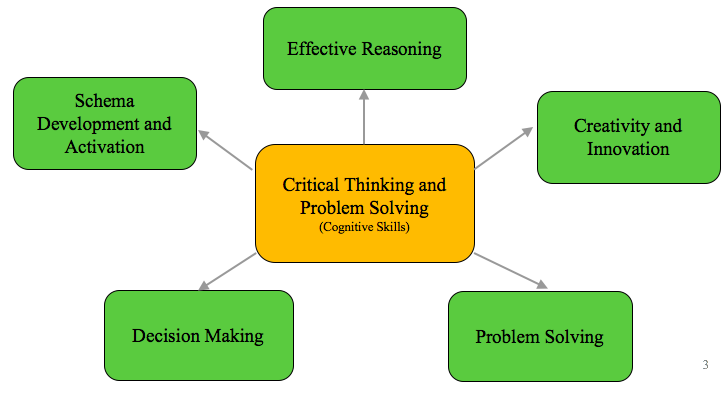
We then created rubrics to provide a concrete vision of what each of these constructs look like in practice. Working with the Stanford Center for Assessment, Learning and Equity (SCALE) , we refined these rubrics to capture clear and discrete skills.
For example, we defined effective reasoning as the skill of creating an evidence-based claim: students need to construct a claim, identify relevant support, link their support to their claim, and identify possible questions or counter claims. Rubrics provide an explicit vision of the skill of effective reasoning for students and teachers. By breaking the rubrics down for different grade bands, we have been able not only to describe what reasoning is but also to delineate how the skills develop in students from preschool through 8th grade.
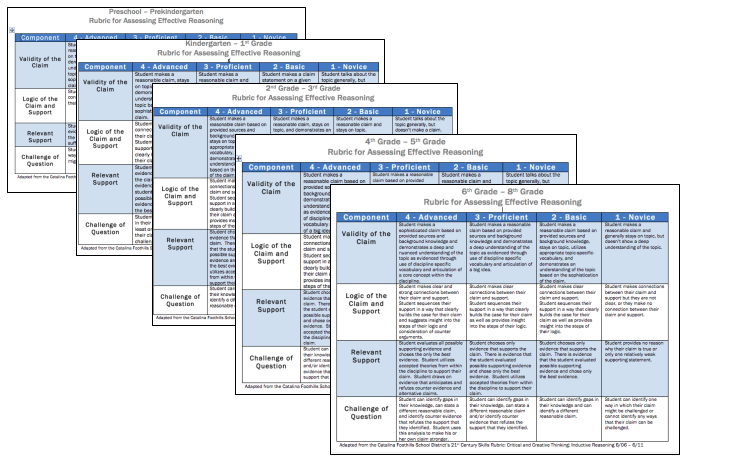
Before moving on, I want to freely acknowledge that in narrowly defining reasoning as the construction of evidence-based claims we have disregarded some elements of reasoning that students can and should learn. For example, the difference between constructing claims through deductive versus inductive means is not highlighted in our definition. However, by privileging a definition that has broad applicability across disciplines, we are able to gain traction in developing the roots of critical thinking. In this case, to formulate well-supported claims or arguments.
Teaching Critical Thinking Skills
The definitions of critical thinking constructs were only useful to us in as much as they translated into practical skills that teachers could teach and students could learn and use. Consequently, we have found that to teach a set of cognitive skills, we needed thinking routines that defined the regular application of these critical thinking and problem-solving skills across domains. Building on Harvard’s Project Zero Visible Thinking work, we have named routines aligned with each of our constructs.
For example, with the construct of effective reasoning, we aligned the Claim-Support-Question thinking routine to our rubric. Teachers then were able to teach students that whenever they were making an argument, the norm in the class was to use the routine in constructing their claim and support. The flexibility of the routine has allowed us to apply it from preschool through 8th grade and across disciplines from science to economics and from math to literacy.
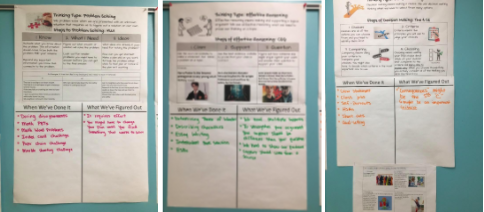
Kathryn Mancino, a 5th grade teacher at Two Rivers, has deliberately taught three of our thinking routines to students using the anchor charts above. Her charts name the components of each routine and has a place for students to record when they’ve used it and what they have figured out about the routine. By using this structure with a chart that can be added to throughout the year, students see the routines as broadly applicable across disciplines and are able to refine their application over time.
Assessing Critical Thinking Skills
By defining specific constructs of critical thinking and building thinking routines that support their implementation in classrooms, we have operated under the assumption that students are developing skills that they will be able to transfer to other settings. However, we recognized both the importance and the challenge of gathering reliable data to confirm this.
With this in mind, we have developed a series of short performance tasks around novel discipline-neutral contexts in which students can apply the constructs of thinking. Through these tasks, we have been able to provide an opportunity for students to demonstrate their ability to transfer the types of thinking beyond the original classroom setting. Once again, we have worked with SCALE to define tasks where students easily access the content but where the cognitive lift requires them to demonstrate their thinking abilities.
These assessments demonstrate that it is possible to capture meaningful data on students’ critical thinking abilities. They are not intended to be high stakes accountability measures. Instead, they are designed to give students, teachers, and school leaders discrete formative data on hard to measure skills.
While it is clearly difficult, and we have not solved all of the challenges to scaling assessments of critical thinking, we can define, teach, and assess these skills . In fact, knowing how important they are for the economy of the future and our democracy, it is essential that we do.
Jeff Heyck-Williams (He, His, Him)
Director of the two rivers learning institute.
Jeff Heyck-Williams is the director of the Two Rivers Learning Institute and a founder of Two Rivers Public Charter School. He has led work around creating school-wide cultures of mathematics, developing assessments of critical thinking and problem-solving, and supporting project-based learning.
Read More About Why Schools Need to Change
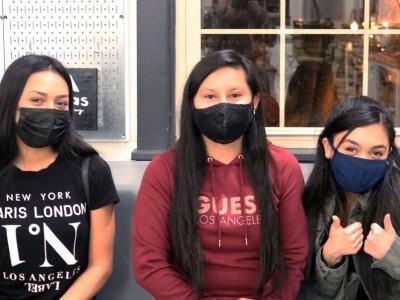
Nurturing STEM Identity and Belonging: The Role of Equitable Program Implementation in Project Invent
Alexis Lopez (she/her)
May 9, 2024

Bring Your Vision for Student Success to Life with NGLC and Bravely
March 13, 2024

For Ethical AI, Listen to Teachers
Jason Wilmot
October 23, 2023
BLOG | PODCAST NETWORK | ADMIN. MASTERMIND | SWAG & MERCH | ONLINE TRAINING

- Meet the Team
- Join the Team
- Our Philosophy
- Teach Better Mindset
- Custom Professional Development
- Livestream Shows & Videos
- Administrator Mastermind
- Academy Online Courses
- EDUcreator Club+
- Podcast Network
- Speakers Network
- EDUpreneur Mastermind
- Free Downloads
- Ambassador Program
- Free Facebook Group
- Professional Development
- Request Training
- Speakers Network Home
- Keynote Speakers
Strategies to Increase Critical Thinking Skills in students
Matthew Joseph October 2, 2019 Blog , Engage Better , Lesson Plan Better , Personalize Student Learning Better

In This Post:
- The importance of helping students increase critical thinking skills.
- Ways to promote the essential skills needed to analyze and evaluate.
- Strategies to incorporate critical thinking into your instruction.
We ask our teachers to be “future-ready” or say that we are teaching “for jobs that don’t exist yet.” These are powerful statements. At the same time, they give teachers the impression that we have to drastically change what we are doing .
So how do we plan education for an unknown job market or unknown needs?
My answer: We can’t predict the jobs, but whatever they are, students will need to think critically to do them. So, our job is to teach our students HOW to think, not WHAT to think.
Helping Students Become Critical Thinkers
My answer is rooted in the call to empower our students to be critical thinkers. I believe that to be critical thinkers, educators need to provide students with the strategies they need. And we need to ask more than just surface-level questions.
Questions to students must motivate them to dig up background knowledge. They should inspire them to make connections to real-world scenarios. These make the learning more memorable and meaningful.
Critical thinking is a general term. I believe this term means that students effectively identify, analyze, and evaluate content or skills. In this process, they (the students) will discover and present convincing reasons in support of their answers or thinking.
You can look up critical thinking and get many definitions like this one from Wikipedia: “ Critical thinking consists of a mental process of analyzing or evaluating information, particularly statements or propositions that people have offered as true. ”
Essential Skills for Critical Thinking
In my current role as director of curriculum and instruction, I work to promote the use of 21st-century tools and, more importantly, thinking skills. Some essential skills that are the basis for critical thinking are:
- Communication and Information skills
- Thinking and Problem-Solving skills
- Interpersonal and Self- Directional skills
- Collaboration skills
These four bullets are skills students are going to need in any field and in all levels of education. Hence my answer to the question. We need to teach our students to think critically and for themselves.
One of the goals of education is to prepare students to learn through discovery . Providing opportunities to practice being critical thinkers will assist students in analyzing others’ thinking and examining the logic of others.
Understanding others is an essential skill in collaboration and in everyday life. Critical thinking will allow students to do more than just memorize knowledge.
Ask Questions
So how do we do this? One recommendation is for educators to work in-depth questioning strategies into a lesson launch.
Ask thoughtful questions to allow for answers with sound reasoning. Then, word conversations and communication to shape students’ thinking. Quick answers often result in very few words and no eye contact, which are skills we don’t want to promote.
When you are asking students questions and they provide a solution, try some of these to promote further thinking:
- Could you elaborate further on that point?
- Will you express that point in another way?
- Can you give me an illustration?
- Would you give me an example?
- Will you you provide more details?
- Could you be more specific?
- Do we need to consider another point of view?
- Is there another way to look at this question?
Utilizing critical thinking skills could be seen as a change in the paradigm of teaching and learning. Engagement in education will enhance the collaboration among teachers and students. It will also provide a way for students to succeed even if the school system had to start over.
[scroll down to keep reading]
Promoting critical thinking into all aspects of instruction.
Engagement, application, and collaboration are skills that withstand the test of time. I also promote the integration of critical thinking into every aspect of instruction.
In my experience, I’ve found a few ways to make this happen.
Begin lessons/units with a probing question: It shouldn’t be a question you can answer with a ‘yes’ or a ‘no.’ These questions should inspire discovery learning and problem-solving.
Encourage Creativity: I have seen teachers prepare projects before they give it to their students many times. For example, designing snowmen or other “creative” projects. By doing the design work or by cutting all the circles out beforehand, it removes creativity options.
It may help the classroom run more smoothly if every child’s material is already cut out, but then every student’s project looks the same. Students don’t have to think on their own or problem solve.
Not having everything “glue ready” in advance is a good thing. Instead, give students all the supplies needed to create a snowman, and let them do it on their own.
Giving independence will allow students to become critical thinkers because they will have to create their own product with the supplies you give them. This might be an elementary example, but it’s one we can relate to any grade level or project.
Try not to jump to help too fast – let the students work through a productive struggle .
Build in opportunities for students to find connections in learning. Encouraging students to make connections to a real-life situation and identify patterns is a great way to practice their critical thinking skills. The use of real-world scenarios will increase rigor, relevance, and critical thinking.
A few other techniques to encourage critical thinking are:
- Use analogies
- Promote interaction among students
- Ask open-ended questions
- Allow reflection time
- Use real-life problems
- Allow for thinking practice
Critical thinking prepares students to think for themselves for the rest of their lives. I also believe critical thinkers are less likely to go along with the crowd because they think for themselves.
About Matthew X. Joseph, Ed.D.
Dr. Matthew X. Joseph has been a school and district leader in many capacities in public education over his 25 years in the field. Experiences such as the Director of Digital Learning and Innovation in Milford Public Schools (MA), elementary school principal in Natick, MA and Attleboro, MA, classroom teacher, and district professional development specialist have provided Matt incredible insights on how to best support teaching and learning. This experience has led to nationally publishing articles and opportunities to speak at multiple state and national events. He is the author of Power of Us: Creating Collaborative Schools and co-author of Modern Mentoring , Reimagining Teacher Mentorship (Due out, fall 2019). His master’s degree is in special education and his Ed.D. in Educational Leadership from Boston College.
Visit Matthew’s Blog

- Grades 6-12
- School Leaders
Free end-of-year letter templates to your students 📝!
100+ Critical Thinking Questions for Students To Ask About Anything
Critical thinkers question everything.
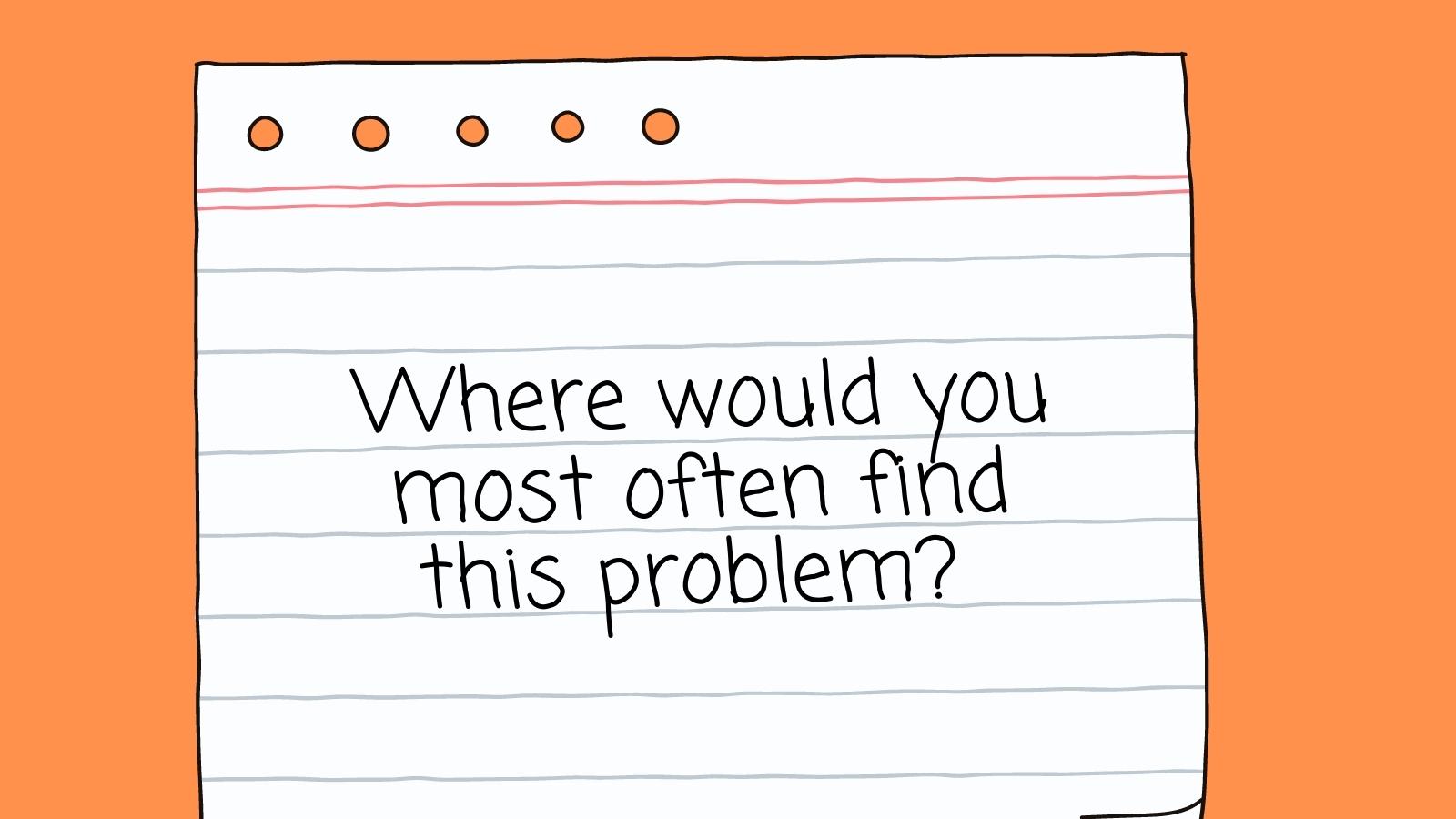
In an age of “fake news” claims and constant argument about pretty much any issue, critical thinking skills are key. Teach your students that it’s vital to ask questions about everything, but that it’s also important to ask the right sorts of questions. Students can use these critical thinking questions with fiction or nonfiction texts. They’re also useful when discussing important issues or trying to understand others’ motivations in general.
“Who” Critical Thinking Questions
Questions like these help students ponder who’s involved in a story and how the actions affect them. They’ll also consider who’s telling the tale and how reliable that narrator might be.
- Is the protagonist?
- Is the antagonist?
- Caused harm?
- Is harmed as a result?
- Was the most important character?
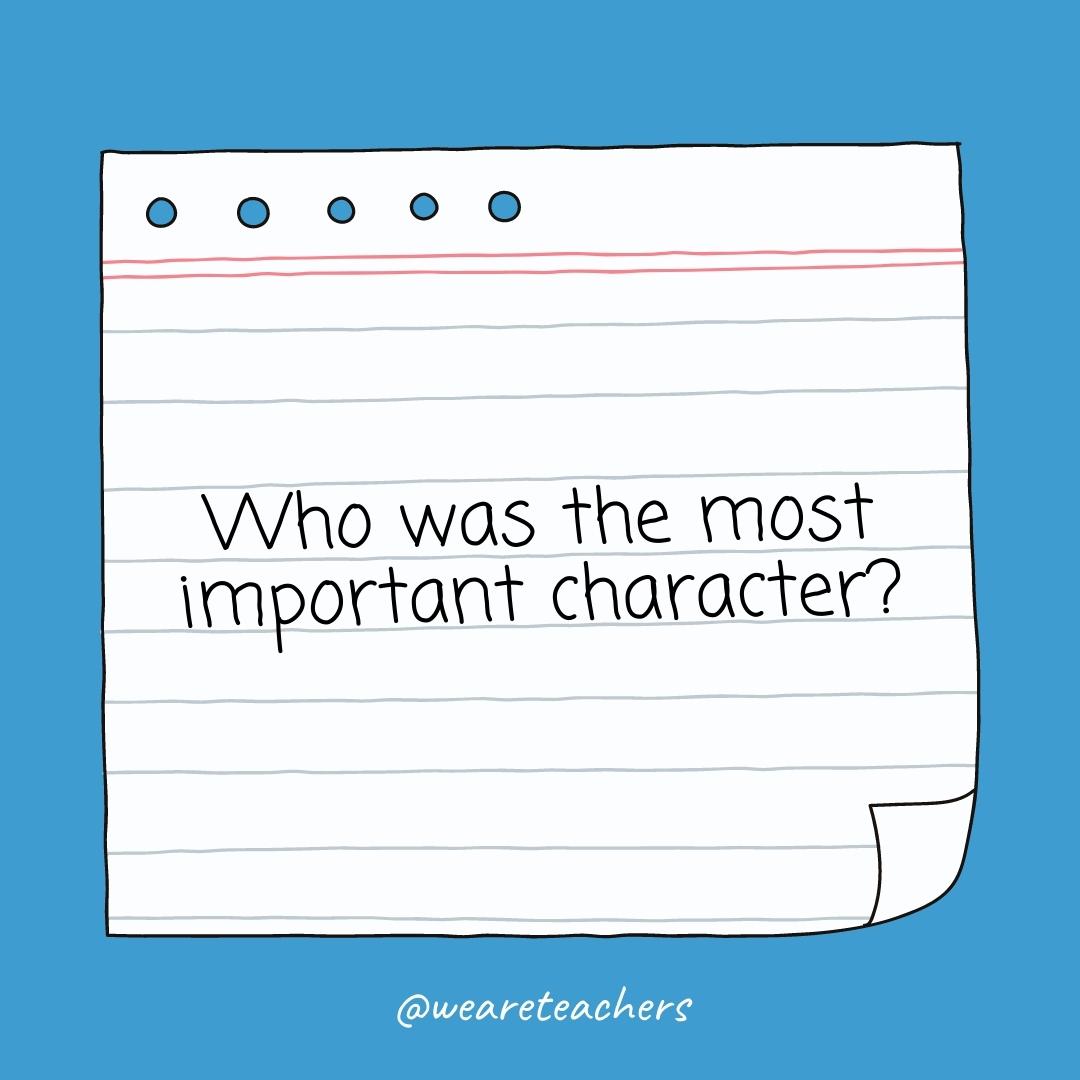
- Is responsible?
- Is most directly affected?
- Should have won?
- Will benefit?
- Would be affected by this?
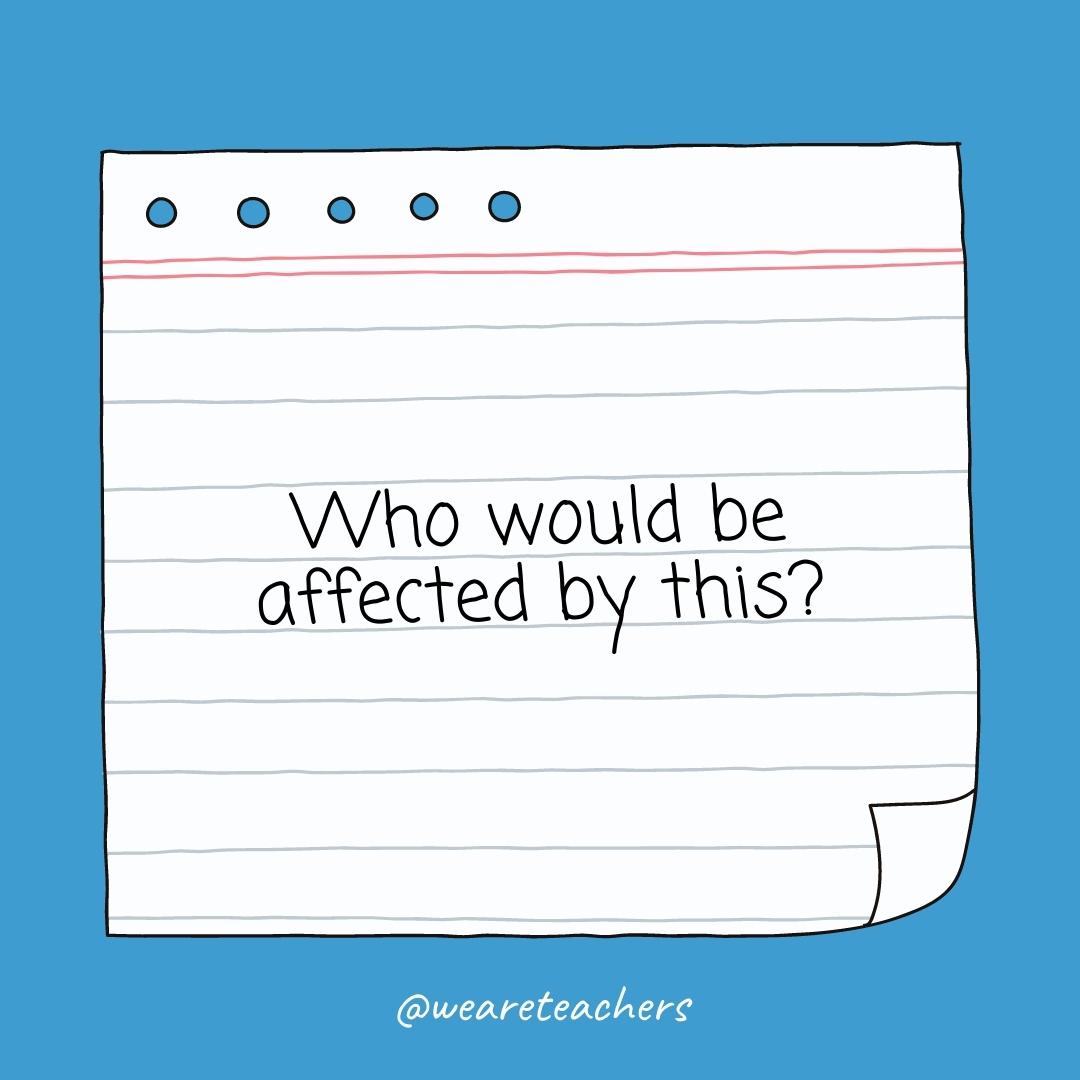
- Makes the decisions?
“What” Critical Thinking Questions
Ask questions that explore issues more deeply, including those that might not be directly answered in the text.
- Background information do I know or need to know?
- Is the main message?
- Are the defining characteristics?
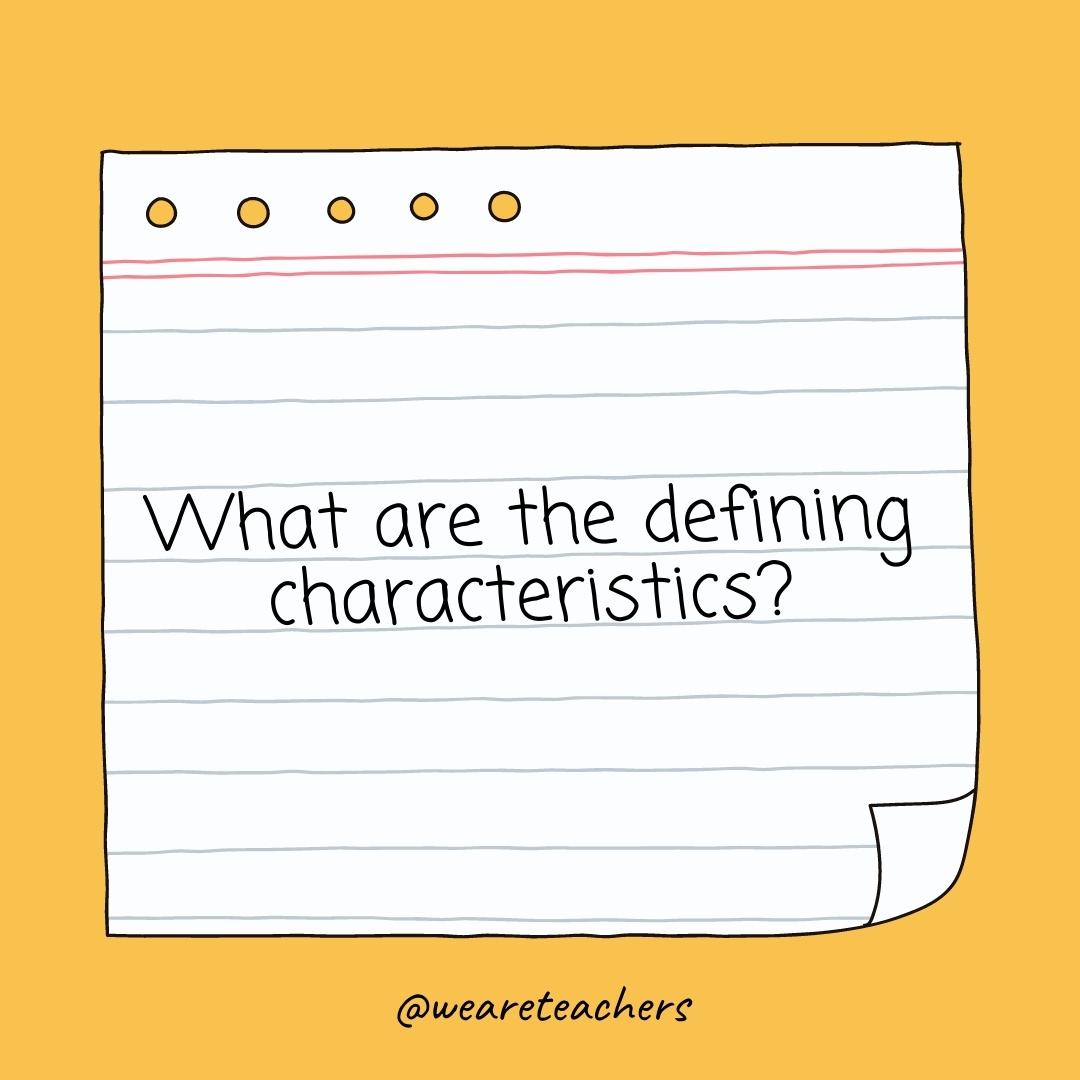
- Questions or concerns do I have?
- Don’t I understand?
- Evidence supports the author’s conclusion?
- Would it be like if … ?
- Could happen if … ?
- Other outcomes might have happened?
- Questions would you have asked?
- Would you ask the author about … ?
- Was the point of … ?
- Should have happened instead?
- Is that character’s motive?
- Else could have changed the whole story?
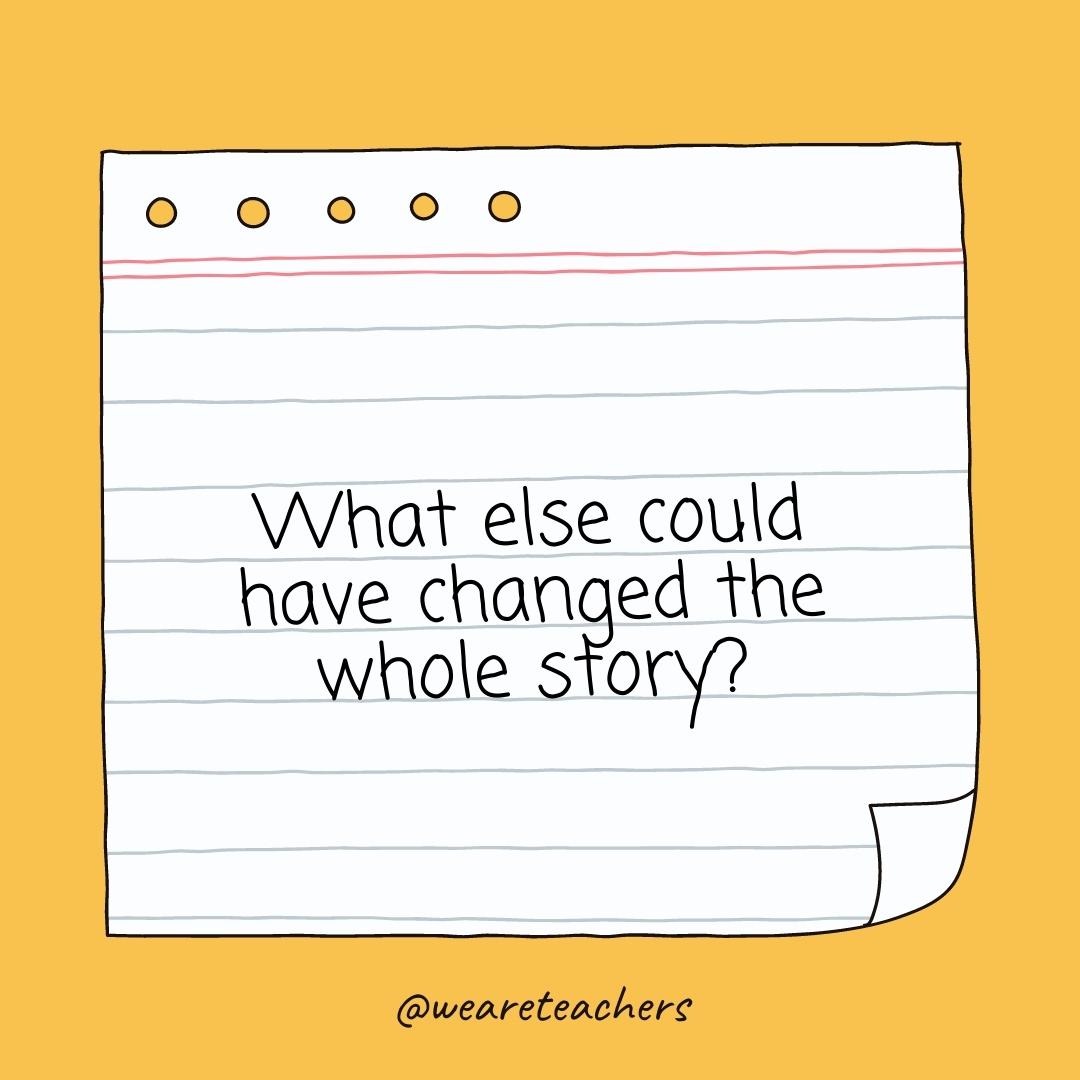
- Can you conclude?
- Would your position have been in that situation?
- Would happen if … ?
- Makes your position stronger?
- Was the turning point?
- Is the point of the question?
- Did it mean when … ?
- Is the other side of this argument?
- Was the purpose of … ?
- Does ______ mean?
- Is the problem you are trying to solve?
- Does the evidence say?
- Assumptions are you making?
- Is a better alternative?
- Are the strengths of the argument?
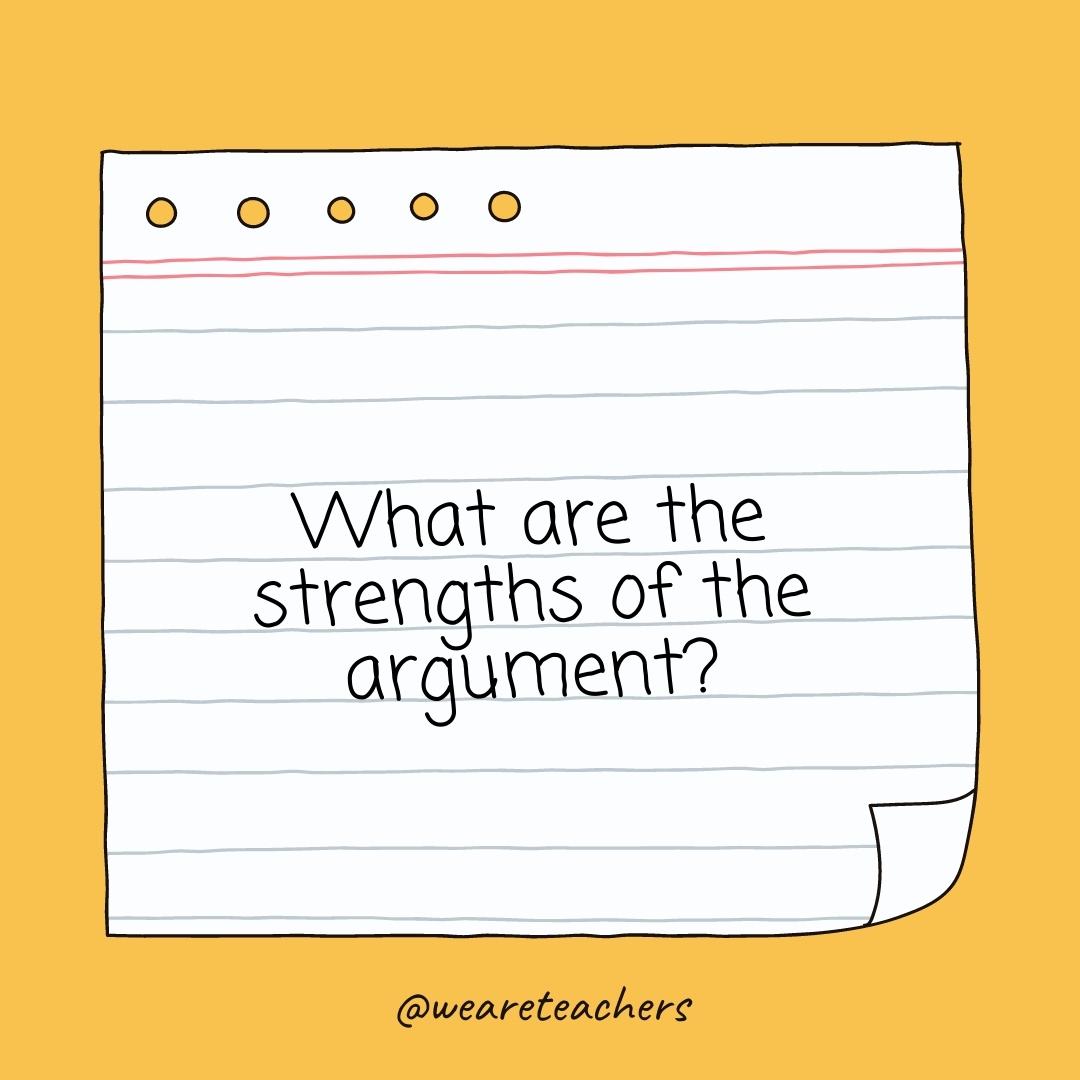
- Are the weaknesses of the argument?
- Is the difference between _______ and _______?
“Where” Critical Thinking Questions
Think about where the story is set and how it affects the actions. Plus, consider where and how you can learn more.
- Would this issue be a major problem?
- Are areas for improvement?
- Did the story change?
- Would you most often find this problem?

- Are there similar situations?
- Would you go to get answers to this problem?
- Can this be improved?
- Can you get more information?
- Will this idea take us?
“When” Critical Thinking Questions
Think about timing and the effect it has on the characters or people involved.
- Is this acceptable?
- Is this unacceptable?
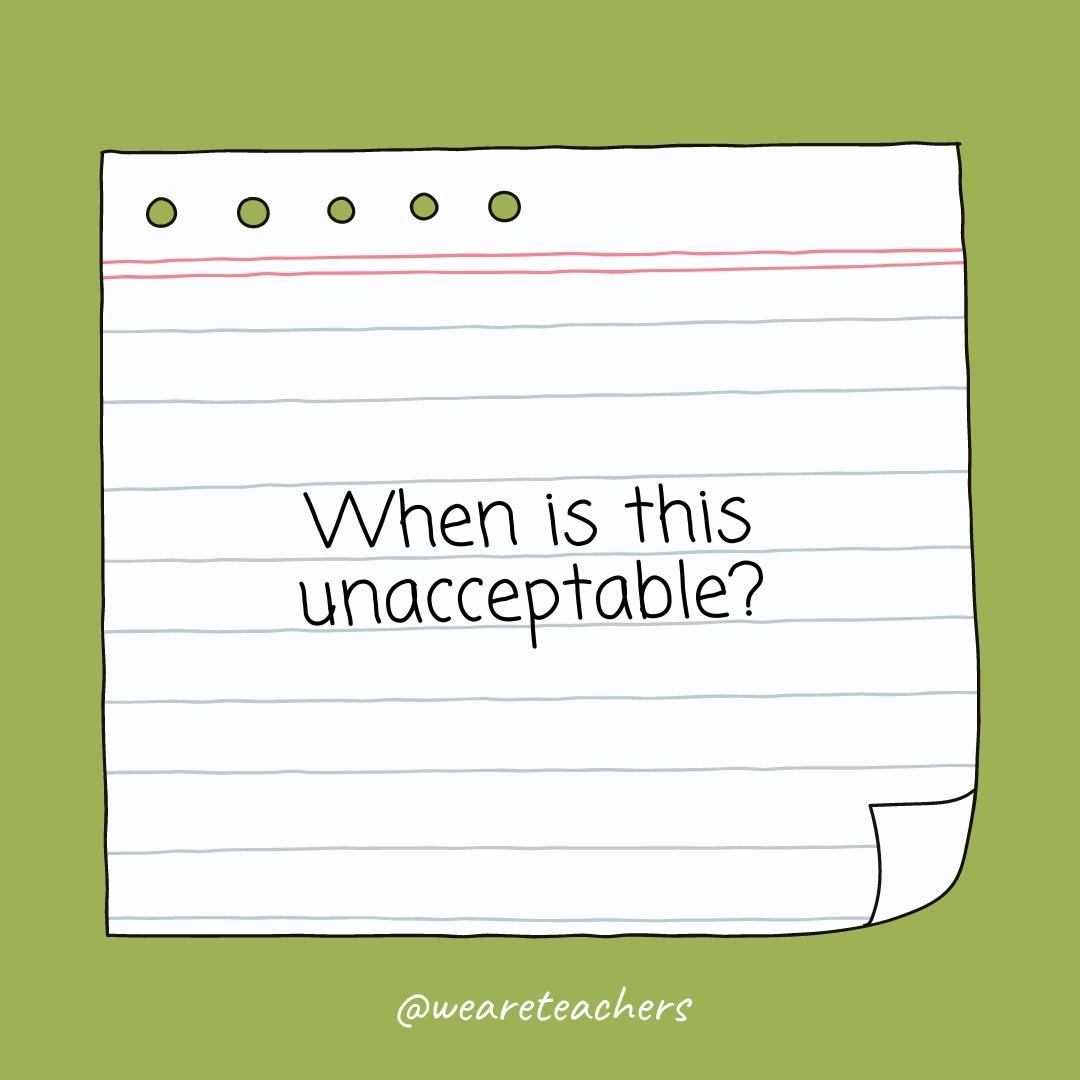
- Does this become a problem?
- Is the best time to take action?
- Will we be able to tell if it worked?
- Is it time to reassess?
- Should we ask for help?
- Is the best time to start?
- Is it time to stop?
- Would this benefit society?
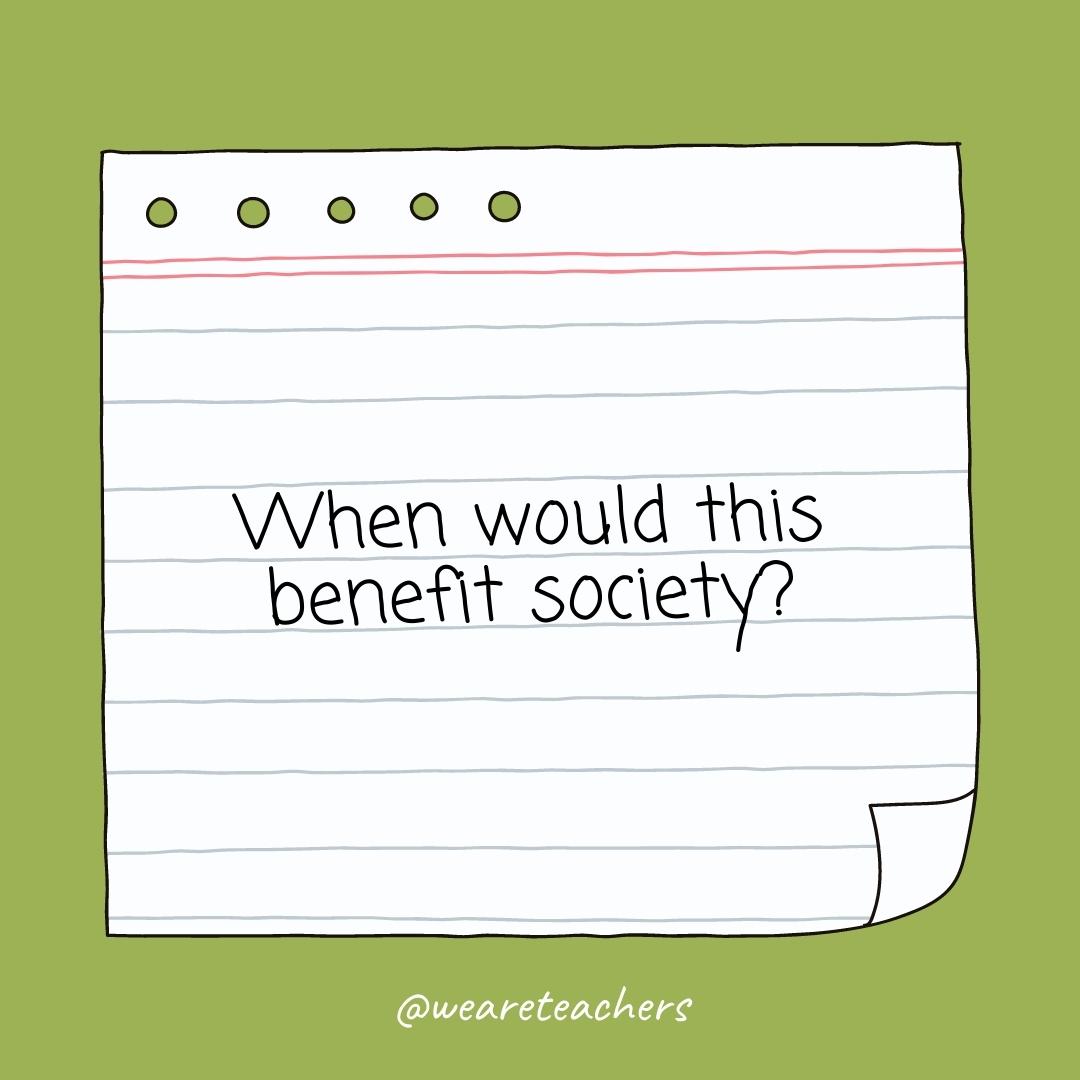
- Has this happened before?
“Why” Critical Thinking Questions
Asking “why” might be one of the most important parts of critical thinking. Exploring and understanding motivation helps develop empathy and make sense of difficult situations.
- Is _________ happening?
- Have we allowed this to happen?
- Should people care about this issue?
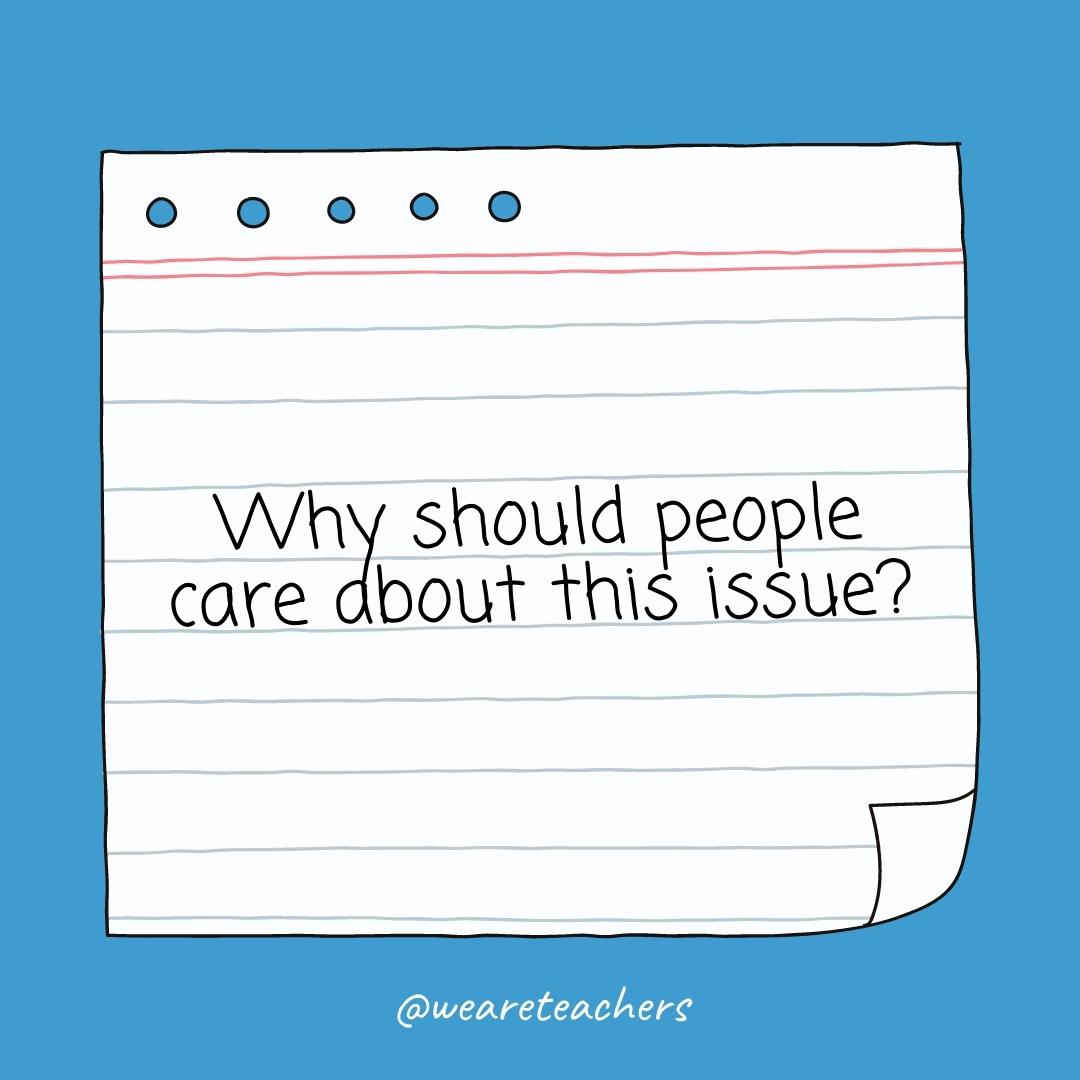
- Is this a problem?
- Did the character say … ?
- Did the character do … ?
- Is this relevant?
- Did the author write this?
- Did the author decide to … ?
- Is this important?
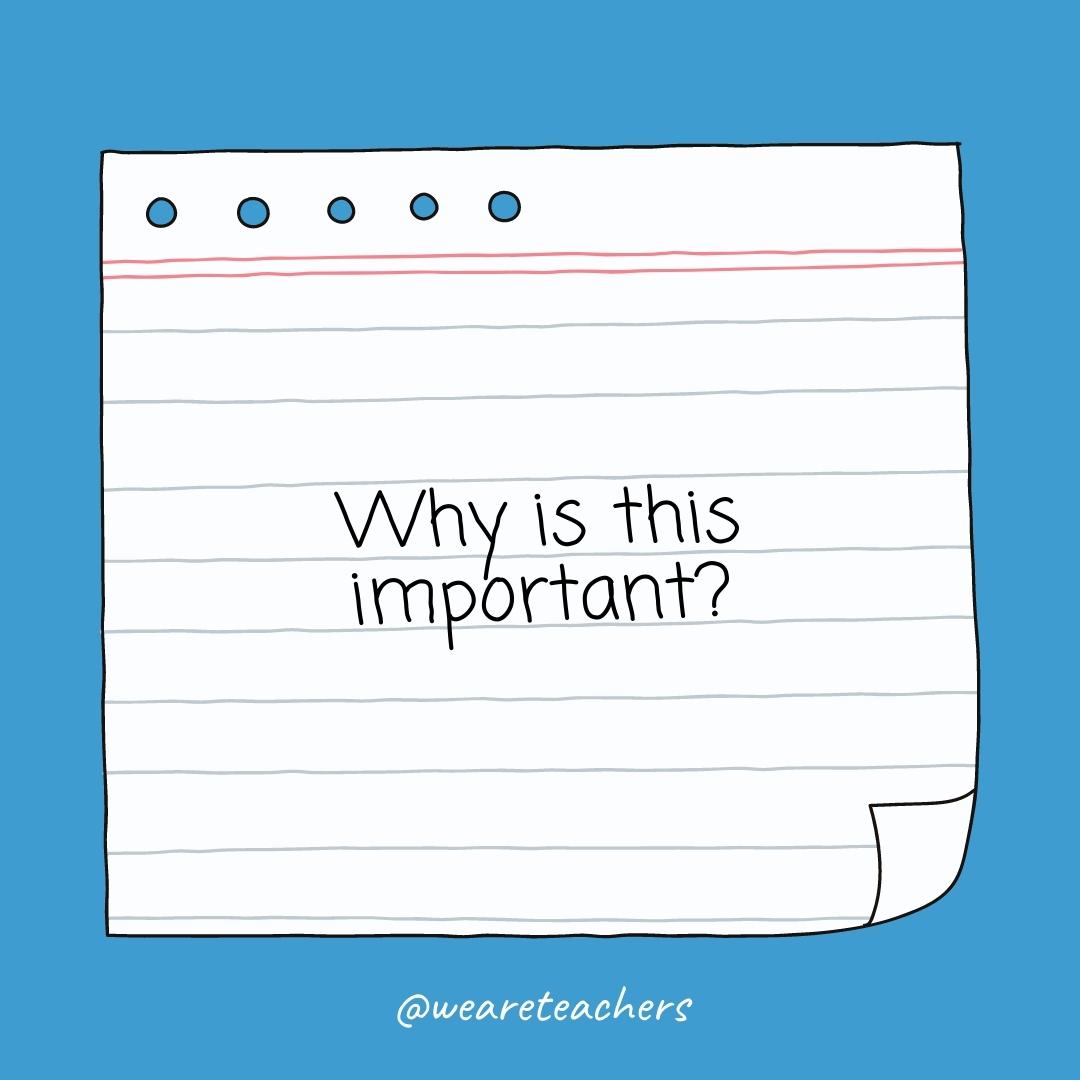
- Did that happen?
- Is it necessary?
- Do you think I (he, she, they) asked that question?
- Is that answer the best one?
- Do we need this today?
“How” Critical Thinking Questions
Use these questions to consider how things happen and whether change is possible.
- Do we know this is true?
- Does the language used affect the story?
- Would you solve … ?
- Is this different from other situations?
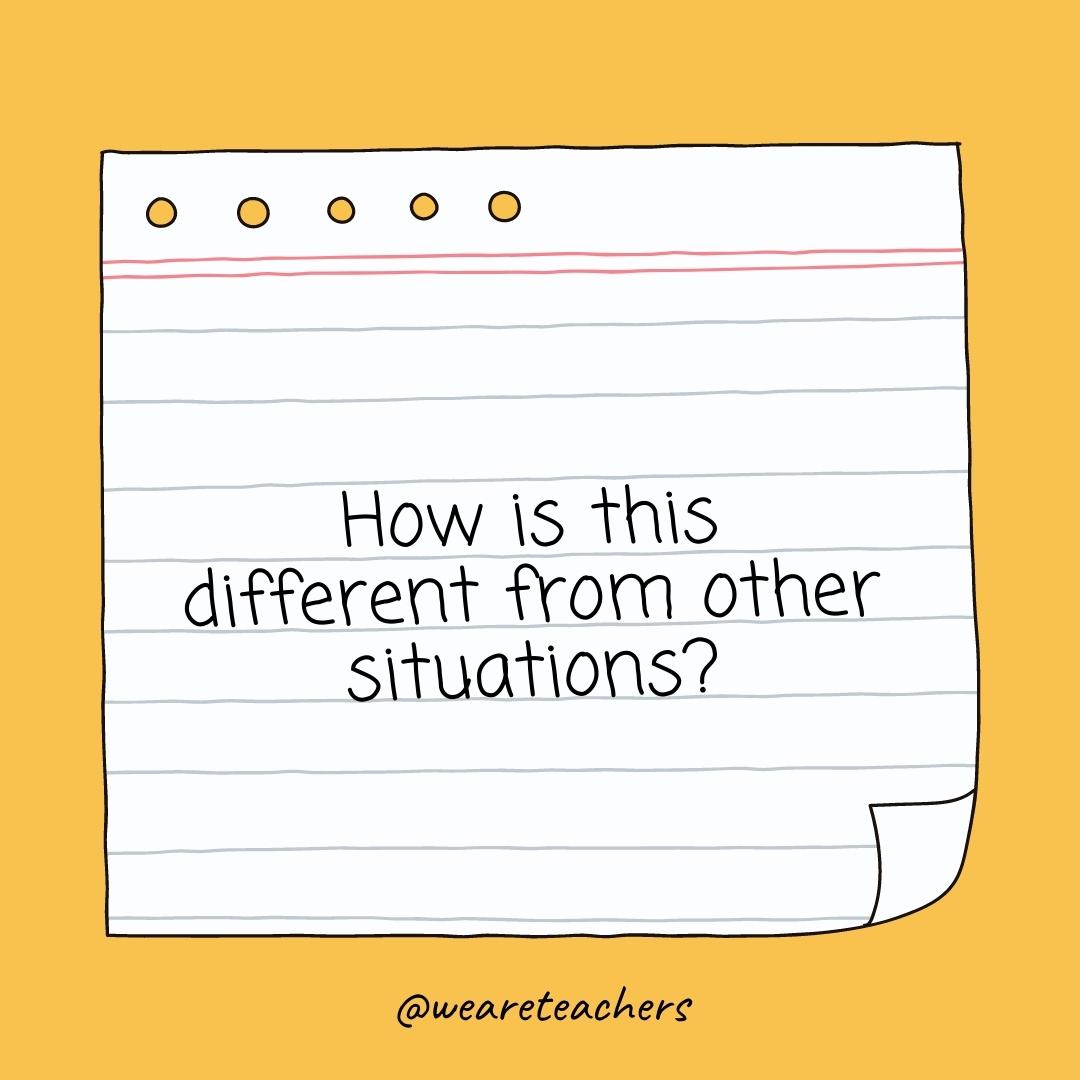
- Is this similar to … ?
- Would you use … ?
- Does the location affect the story?
- Could the story have ended differently?
- Does this work?
- Could this be harmful?
- Does this connect with what I already know?
- Else could this have been handled?
- Should they have responded?
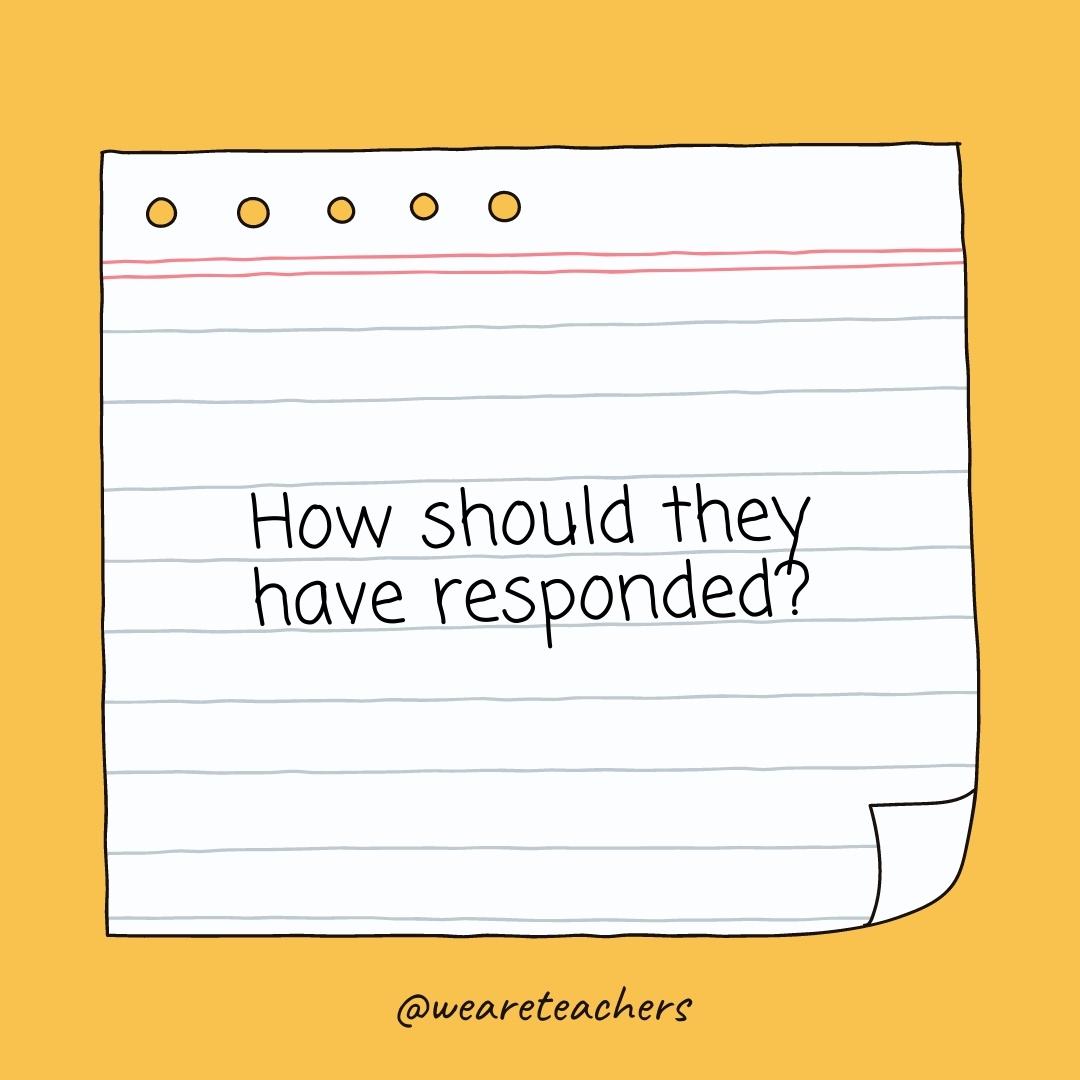
- Would you feel about … ?
- Does this change the outcome?
- Did you make that decision?
- Does this benefit you/others?
- Does this hurt you/others?
- Could this problem be avoided?
More Critical Thinking Questions
Here are more questions to help probe further and deepen understanding.
- Can you give me an example?
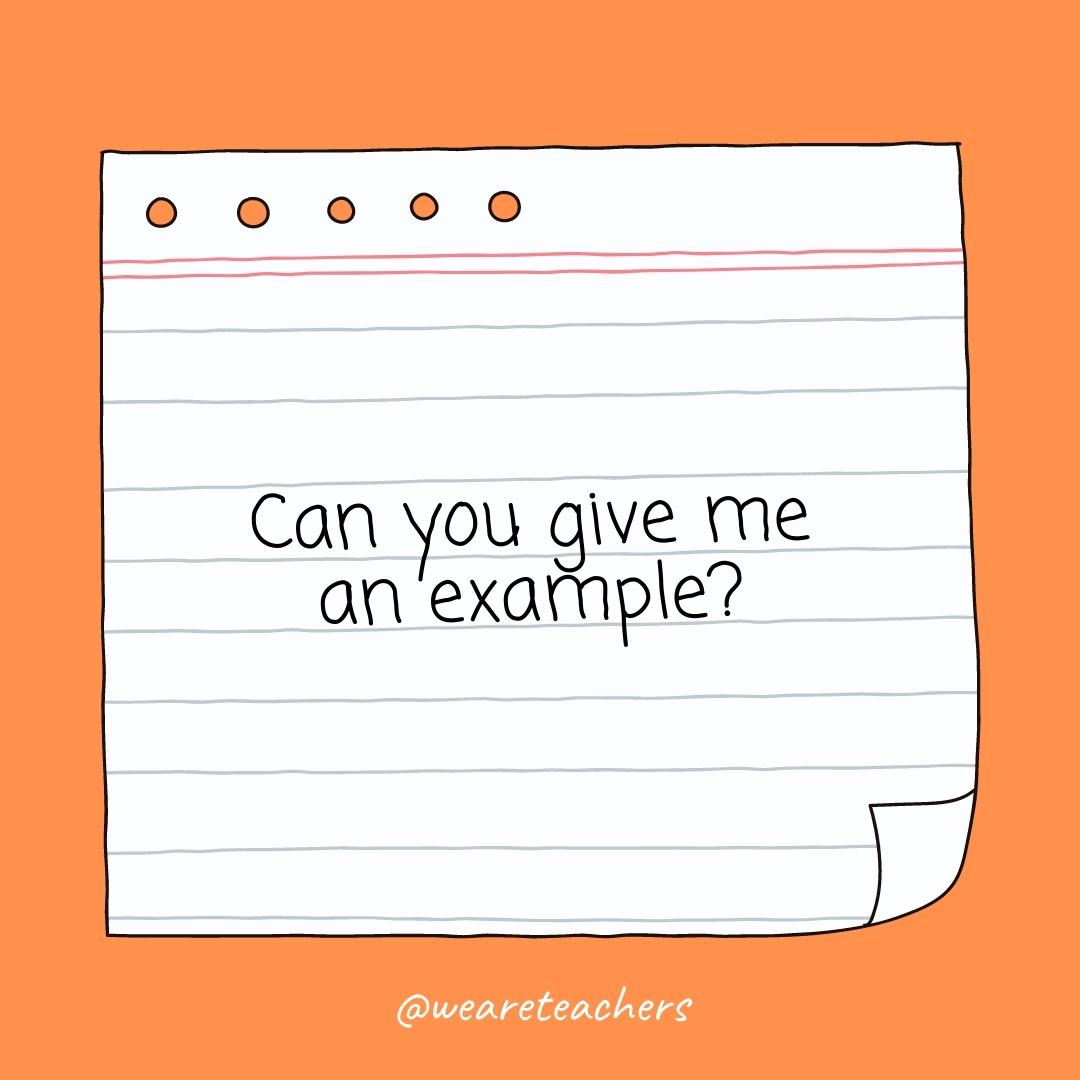
- Do you agree with … ?
- Can you compare this with … ?
- Can you defend the actions of … ?
- Could this be interpreted differently?
- Is the narrator reliable?
- Does it seem too good to be true?
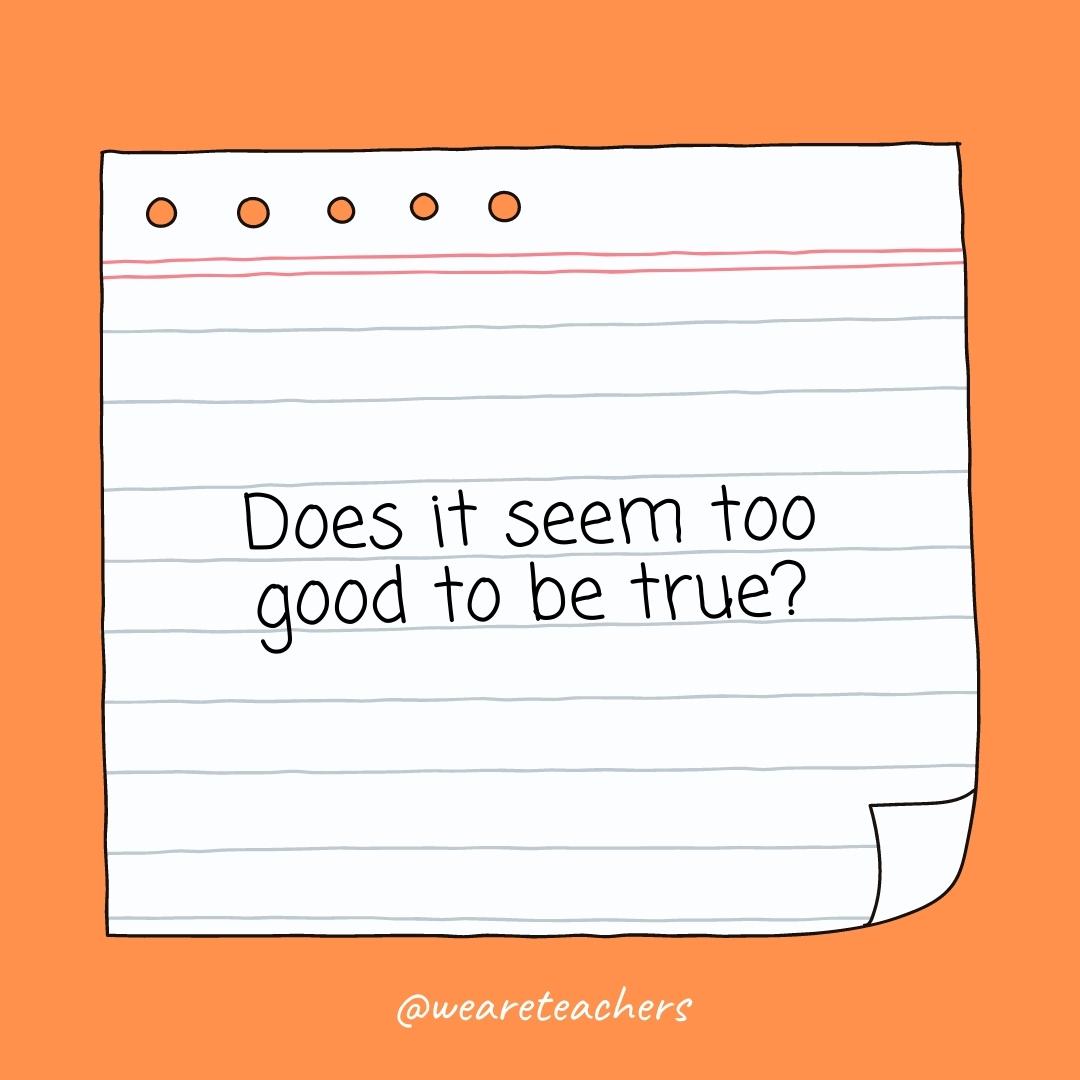
- Is ______ a fact or an opinion?
What are your favorite critical thinking questions? Come exchange ideas on the WeAreTeachers HELPLINE group on Facebook .
Plus, check out 10 tips for teaching kids to be awesome critical thinkers ., you might also like.

5 Critical Thinking Skills Every Kid Needs To Learn (And How To Teach Them)
Teach them to thoughtfully question the world around them. Continue Reading
Copyright © 2024. All rights reserved. 5335 Gate Parkway, Jacksonville, FL 32256

Tips for Online Students , Tips for Students
Why Is Critical Thinking Important? A Survival Guide
Updated: December 7, 2023
Published: April 2, 2020

Why is critical thinking important? The decisions that you make affect your quality of life. And if you want to ensure that you live your best, most successful and happy life, you’re going to want to make conscious choices. That can be done with a simple thing known as critical thinking. Here’s how to improve your critical thinking skills and make decisions that you won’t regret.
What Is Critical Thinking?
You’ve surely heard of critical thinking, but you might not be entirely sure what it really means, and that’s because there are many definitions. For the most part, however, we think of critical thinking as the process of analyzing facts in order to form a judgment. Basically, it’s thinking about thinking.
How Has The Definition Evolved Over Time?
The first time critical thinking was documented is believed to be in the teachings of Socrates , recorded by Plato. But throughout history, the definition has changed.
Today it is best understood by philosophers and psychologists and it’s believed to be a highly complex concept. Some insightful modern-day critical thinking definitions include :
- “Reasonable, reflective thinking that is focused on deciding what to believe or do.”
- “Deciding what’s true and what you should do.”
The Importance Of Critical Thinking
Why is critical thinking important? Good question! Here are a few undeniable reasons why it’s crucial to have these skills.
1. Critical Thinking Is Universal
Critical thinking is a domain-general thinking skill. What does this mean? It means that no matter what path or profession you pursue, these skills will always be relevant and will always be beneficial to your success. They are not specific to any field.
2. Crucial For The Economy
Our future depends on technology, information, and innovation. Critical thinking is needed for our fast-growing economies, to solve problems as quickly and as effectively as possible.
3. Improves Language & Presentation Skills
In order to best express ourselves, we need to know how to think clearly and systematically — meaning practice critical thinking! Critical thinking also means knowing how to break down texts, and in turn, improve our ability to comprehend.
4. Promotes Creativity
By practicing critical thinking, we are allowing ourselves not only to solve problems but also to come up with new and creative ideas to do so. Critical thinking allows us to analyze these ideas and adjust them accordingly.
5. Important For Self-Reflection
Without critical thinking, how can we really live a meaningful life? We need this skill to self-reflect and justify our ways of life and opinions. Critical thinking provides us with the tools to evaluate ourselves in the way that we need to.

6. The Basis Of Science & Democracy
In order to have a democracy and to prove scientific facts, we need critical thinking in the world. Theories must be backed up with knowledge. In order for a society to effectively function, its citizens need to establish opinions about what’s right and wrong (by using critical thinking!).
Benefits Of Critical Thinking
We know that critical thinking is good for society as a whole, but what are some benefits of critical thinking on an individual level? Why is critical thinking important for us?
1. Key For Career Success
Critical thinking is crucial for many career paths. Not just for scientists, but lawyers , doctors, reporters, engineers , accountants, and analysts (among many others) all have to use critical thinking in their positions. In fact, according to the World Economic Forum, critical thinking is one of the most desirable skills to have in the workforce, as it helps analyze information, think outside the box, solve problems with innovative solutions, and plan systematically.
2. Better Decision Making
There’s no doubt about it — critical thinkers make the best choices. Critical thinking helps us deal with everyday problems as they come our way, and very often this thought process is even done subconsciously. It helps us think independently and trust our gut feeling.
3. Can Make You Happier!
While this often goes unnoticed, being in touch with yourself and having a deep understanding of why you think the way you think can really make you happier. Critical thinking can help you better understand yourself, and in turn, help you avoid any kind of negative or limiting beliefs, and focus more on your strengths. Being able to share your thoughts can increase your quality of life.
4. Form Well-Informed Opinions
There is no shortage of information coming at us from all angles. And that’s exactly why we need to use our critical thinking skills and decide for ourselves what to believe. Critical thinking allows us to ensure that our opinions are based on the facts, and help us sort through all that extra noise.
5. Better Citizens
One of the most inspiring critical thinking quotes is by former US president Thomas Jefferson: “An educated citizenry is a vital requisite for our survival as a free people.” What Jefferson is stressing to us here is that critical thinkers make better citizens, as they are able to see the entire picture without getting sucked into biases and propaganda.
6. Improves Relationships
While you may be convinced that being a critical thinker is bound to cause you problems in relationships, this really couldn’t be less true! Being a critical thinker can allow you to better understand the perspective of others, and can help you become more open-minded towards different views.
7. Promotes Curiosity
Critical thinkers are constantly curious about all kinds of things in life, and tend to have a wide range of interests. Critical thinking means constantly asking questions and wanting to know more, about why, what, who, where, when, and everything else that can help them make sense of a situation or concept, never taking anything at face value.
8. Allows For Creativity
Critical thinkers are also highly creative thinkers, and see themselves as limitless when it comes to possibilities. They are constantly looking to take things further, which is crucial in the workforce.

9. Enhances Problem Solving Skills
Those with critical thinking skills tend to solve problems as part of their natural instinct. Critical thinkers are patient and committed to solving the problem, similar to Albert Einstein, one of the best critical thinking examples, who said “It’s not that I’m so smart; it’s just that I stay with problems longer.” Critical thinkers’ enhanced problem-solving skills makes them better at their jobs and better at solving the world’s biggest problems. Like Einstein, they have the potential to literally change the world.
10. An Activity For The Mind
Just like our muscles, in order for them to be strong, our mind also needs to be exercised and challenged. It’s safe to say that critical thinking is almost like an activity for the mind — and it needs to be practiced. Critical thinking encourages the development of many crucial skills such as logical thinking, decision making, and open-mindness.
11. Creates Independence
When we think critically, we think on our own as we trust ourselves more. Critical thinking is key to creating independence, and encouraging students to make their own decisions and form their own opinions.
12. Crucial Life Skill
Critical thinking is crucial not just for learning, but for life overall! Education isn’t just a way to prepare ourselves for life, but it’s pretty much life itself. Learning is a lifelong process that we go through each and every day.
How to Think Critically
Now that you know the benefits of thinking critically, how do you actually do it?
How To Improve Your Critical Thinking
- Define Your Question: When it comes to critical thinking, it’s important to always keep your goal in mind. Know what you’re trying to achieve, and then figure out how to best get there.
- Gather Reliable Information: Make sure that you’re using sources you can trust — biases aside. That’s how a real critical thinker operates!
- Ask The Right Questions: We all know the importance of questions, but be sure that you’re asking the right questions that are going to get you to your answer.
- Look Short & Long Term: When coming up with solutions, think about both the short- and long-term consequences. Both of them are significant in the equation.
- Explore All Sides: There is never just one simple answer, and nothing is black or white. Explore all options and think outside of the box before you come to any conclusions.
How Is Critical Thinking Developed At School?
Critical thinking is developed in nearly everything we do. However, much of this important skill is encouraged to be practiced at school, and rightfully so! Critical thinking goes beyond just thinking clearly — it’s also about thinking for yourself.
When a teacher asks a question in class, students are given the chance to answer for themselves and think critically about what they learned and what they believe to be accurate. When students work in groups and are forced to engage in discussion, this is also a great chance to expand their thinking and use their critical thinking skills.
How Does Critical Thinking Apply To Your Career?
Once you’ve finished school and entered the workforce, your critical thinking journey only expands and grows from here!
Impress Your Employer
Employers value employees who are critical thinkers, ask questions, offer creative ideas, and are always ready to offer innovation against the competition. No matter what your position or role in a company may be, critical thinking will always give you the power to stand out and make a difference.
Careers That Require Critical Thinking
Some of many examples of careers that require critical thinking include:
- Human resources specialist
- Marketing associate
- Business analyst
Truth be told however, it’s probably harder to come up with a professional field that doesn’t require any critical thinking!
Photo by Oladimeji Ajegbile from Pexels
What is someone with critical thinking skills capable of doing.
Someone with critical thinking skills is able to think rationally and clearly about what they should or not believe. They are capable of engaging in their own thoughts, and doing some reflection in order to come to a well-informed conclusion.
A critical thinker understands the connections between ideas, and is able to construct arguments based on facts, as well as find mistakes in reasoning.
The Process Of Critical Thinking
The process of critical thinking is highly systematic.
What Are Your Goals?
Critical thinking starts by defining your goals, and knowing what you are ultimately trying to achieve.
Once you know what you are trying to conclude, you can foresee your solution to the problem and play it out in your head from all perspectives.
What Does The Future Of Critical Thinking Hold?
The future of critical thinking is the equivalent of the future of jobs. In 2020, critical thinking was ranked as the 2nd top skill (following complex problem solving) by the World Economic Forum .
We are dealing with constant unprecedented changes, and what success is today, might not be considered success tomorrow — making critical thinking a key skill for the future workforce.
Why Is Critical Thinking So Important?
Why is critical thinking important? Critical thinking is more than just important! It’s one of the most crucial cognitive skills one can develop.
By practicing well-thought-out thinking, both your thoughts and decisions can make a positive change in your life, on both a professional and personal level. You can hugely improve your life by working on your critical thinking skills as often as you can.
Related Articles

ChatGPT for Teachers
Trauma-informed practices in schools, teacher well-being, cultivating diversity, equity, & inclusion, integrating technology in the classroom, social-emotional development, covid-19 resources, invest in resilience: summer toolkit, civics & resilience, all toolkits, degree programs, trauma-informed professional development, teacher licensure & certification, how to become - career information, classroom management, instructional design, lifestyle & self-care, online higher ed teaching, current events, critical thinking resources for high school teachers.

Developing critical thinking abilities is a necessary skill for all high school students but teaching these skills is not the easiest task for high school teachers. Fortunately, there is a wealth of information online to provide teachers the resources needed for creating critical thinking lesson plans.
These online resources provide lessons plans, videos, and small but helpful tips that can be used everyday in the classroom to reinforce lessons and ideas. Below are some of the top resources for teaching critical thinking to high school students.
A site devoted to all things related to critical thinking
The Critical Thinking Community, from the Center for Critical Thinking, provides one of the best sites for critical thinking resources and has a special section aimed at helping high school teachers prepare appropriate lesson plans: Critical Thinking Community for High School Teachers .
“Critical thinking is essential if we are to get to the root of our problems and develop reasonable solutions,” reads the site’s About Us page. “After all, the quality of everything we do is determined by the quality of our thinking.”
Therefore it’s no surprise that the site provides many free online resources for high school teachers, as well as other materials that can be ordered online for a small fee.
One example of an online resource for critical thinking for high school students is the article “How to Study and Learn (Part One)”. This introductory article lays the ground work for the importance of thinking critically, illustrated by the following passage:
“To study well and learn any subject is to learn how to think with discipline within that subject. It is to learn to think within its logic, to:
- raise vital questions and problems within it, formulating them clearly and precisely
- gather and assess information, using ideas to interpret that information insightfully
- come to well-reasoned conclusions and solutions, testing them against relevant criteria and standards
- adopt the point of view of the discipline, recognizing and assessing, as needs be, its assumptions, implications, and practical consequences
- communicate effectively with others using the language of the discipline and that of educated public discourse
- relate what one is learning in the subject to other subjects and to what is significant in human life”
State critical thinking resources
Additionally, many states offer free online critical thinking resources, such as the handbook compiled by faculty members of Prince George’s Community College and put on Maryland’s official website: Handbook of Critical Thinking Resources .
In addition to providing a wealth of outside information resources, the handbook details how thinking critically can help students while they are in high school and in the future:
“Improving students’ critical thinking skills will help students:
- improve their thinking about their course work
- use sound thinking on tests, assignments, and projects in their courses
- have the strategic, analytical, problem solving, and decision-making skills they need when they transfer to another college
- have the strategic, analytical, problem solving, and decision-making skills they need when they transition to the workplace”
Keeping up to date on current trends
Other sites, such as Edutopia.org, are constantly updated with new information to provide teachers with the most current information possible. The site, which is part of the George Lucas Educational Foundation, is divided by grade level and has a special section focused on producing critical thinking high school students: Grades 9-12 High School .
The site describes three fundamental skills it believes necessary for students to become lifelong learners in the 21 st Century:
- how to find information
- how to assess the quality of information
- how to creatively and effectively use information to accomplish a goal
The site combines original articles and instructional videos with other valuable critical thinking resources from around the globe. The site is set up like a blog and puts the most recent articles at the forefront, and also includes a community forum for both students and teachers to use.
You may also like to read
- Critical Thinking Resources for Middle School Teachers
- Online Resources for High School Calculus
- How Teachers Can Help Prevent High School Dropouts
- Classroom Management Strategies for High School Teachers
- Teachers: How to Strengthen High School Student Engagement
- 5 Tips for Teachers Assigning Essays to High School Students
Categorized as: Tips for Teachers and Classroom Resources
Tagged as: Engaging Activities , High School (Grades: 9-12)
- Online & Campus Bachelor's in Early Childhood...
- Master's in Teaching Online | Distance-Learni...
- A Model for the National Assessment of Higher Order Thinking
- International Critical Thinking Essay Test
- Online Critical Thinking Basic Concepts Test
- Online Critical Thinking Basic Concepts Sample Test
Consequential Validity: Using Assessment to Drive Instruction
Translate this page from English...
*Machine translated pages not guaranteed for accuracy. Click Here for our professional translations.

Critical Thinking Testing and Assessment
The purpose of assessment in instruction is improvement. The purpose of assessing instruction for critical thinking is improving the teaching of discipline-based thinking (historical, biological, sociological, mathematical, etc.) It is to improve students’ abilities to think their way through content using disciplined skill in reasoning. The more particular we can be about what we want students to learn about critical thinking, the better we can devise instruction with that particular end in view.
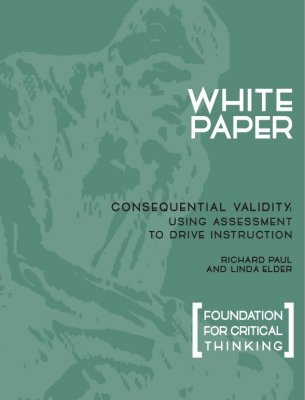
The Foundation for Critical Thinking offers assessment instruments which share in the same general goal: to enable educators to gather evidence relevant to determining the extent to which instruction is teaching students to think critically (in the process of learning content). To this end, the Fellows of the Foundation recommend:
that academic institutions and units establish an oversight committee for critical thinking, and
that this oversight committee utilizes a combination of assessment instruments (the more the better) to generate incentives for faculty, by providing them with as much evidence as feasible of the actual state of instruction for critical thinking.
The following instruments are available to generate evidence relevant to critical thinking teaching and learning:
Course Evaluation Form : Provides evidence of whether, and to what extent, students perceive faculty as fostering critical thinking in instruction (course by course). Machine-scoreable.
Online Critical Thinking Basic Concepts Test : Provides evidence of whether, and to what extent, students understand the fundamental concepts embedded in critical thinking (and hence tests student readiness to think critically). Machine-scoreable.
Critical Thinking Reading and Writing Test : Provides evidence of whether, and to what extent, students can read closely and write substantively (and hence tests students' abilities to read and write critically). Short-answer.
International Critical Thinking Essay Test : Provides evidence of whether, and to what extent, students are able to analyze and assess excerpts from textbooks or professional writing. Short-answer.
Commission Study Protocol for Interviewing Faculty Regarding Critical Thinking : Provides evidence of whether, and to what extent, critical thinking is being taught at a college or university. Can be adapted for high school. Based on the California Commission Study . Short-answer.
Protocol for Interviewing Faculty Regarding Critical Thinking : Provides evidence of whether, and to what extent, critical thinking is being taught at a college or university. Can be adapted for high school. Short-answer.
Protocol for Interviewing Students Regarding Critical Thinking : Provides evidence of whether, and to what extent, students are learning to think critically at a college or university. Can be adapted for high school). Short-answer.
Criteria for Critical Thinking Assignments : Can be used by faculty in designing classroom assignments, or by administrators in assessing the extent to which faculty are fostering critical thinking.
Rubrics for Assessing Student Reasoning Abilities : A useful tool in assessing the extent to which students are reasoning well through course content.
All of the above assessment instruments can be used as part of pre- and post-assessment strategies to gauge development over various time periods.
Consequential Validity
All of the above assessment instruments, when used appropriately and graded accurately, should lead to a high degree of consequential validity. In other words, the use of the instruments should cause teachers to teach in such a way as to foster critical thinking in their various subjects. In this light, for students to perform well on the various instruments, teachers will need to design instruction so that students can perform well on them. Students cannot become skilled in critical thinking without learning (first) the concepts and principles that underlie critical thinking and (second) applying them in a variety of forms of thinking: historical thinking, sociological thinking, biological thinking, etc. Students cannot become skilled in analyzing and assessing reasoning without practicing it. However, when they have routine practice in paraphrasing, summarizing, analyzing, and assessing, they will develop skills of mind requisite to the art of thinking well within any subject or discipline, not to mention thinking well within the various domains of human life.
For full copies of this and many other critical thinking articles, books, videos, and more, join us at the Center for Critical Thinking Community Online - the world's leading online community dedicated to critical thinking! Also featuring interactive learning activities, study groups, and even a social media component, this learning platform will change your conception of intellectual development.
- SUGGESTED TOPICS
- The Magazine
- Newsletters
- Managing Yourself
- Managing Teams
- Work-life Balance
- The Big Idea
- Data & Visuals
- Reading Lists
- Case Selections
- HBR Learning
- Topic Feeds
- Account Settings
- Email Preferences
A Short Guide to Building Your Team’s Critical Thinking Skills
- Matt Plummer

Critical thinking isn’t an innate skill. It can be learned.
Most employers lack an effective way to objectively assess critical thinking skills and most managers don’t know how to provide specific instruction to team members in need of becoming better thinkers. Instead, most managers employ a sink-or-swim approach, ultimately creating work-arounds to keep those who can’t figure out how to “swim” from making important decisions. But it doesn’t have to be this way. To demystify what critical thinking is and how it is developed, the author’s team turned to three research-backed models: The Halpern Critical Thinking Assessment, Pearson’s RED Critical Thinking Model, and Bloom’s Taxonomy. Using these models, they developed the Critical Thinking Roadmap, a framework that breaks critical thinking down into four measurable phases: the ability to execute, synthesize, recommend, and generate.
With critical thinking ranking among the most in-demand skills for job candidates , you would think that educational institutions would prepare candidates well to be exceptional thinkers, and employers would be adept at developing such skills in existing employees. Unfortunately, both are largely untrue.
- Matt Plummer (@mtplummer) is the founder of Zarvana, which offers online programs and coaching services to help working professionals become more productive by developing time-saving habits. Before starting Zarvana, Matt spent six years at Bain & Company spin-out, The Bridgespan Group, a strategy and management consulting firm for nonprofits, foundations, and philanthropists.
Partner Center
- Augsburg.edu
- Inside Augsburg
Search Strommen Center for Meaningful Work
- Faculty & Staff
- Graduate Students
- First Generation
- International
- Students With Disabilities
- Undocumented
- Business & Finance
- Culture and Language
- Environmental Sustainability
- Government, Law & Policy
- Health Professions
- Human & Social Services
- Information Technology & Data
- Marketing, Media & Communications
- Resumes and Cover Letters
- Expand Your Network / Mentor
- Explore Your Interests / Self Assessment
- Negotiate an Offer
- Prepare for an Interview
- Prepare for Graduate School
- Search for a Job / Internship
- Job Fair Preparation
- Start Your Internship
- Choosing a Major
- Career Collaborative
- Travelers EDGE
- Meet the Team
Critical Thinking: A Simple Guide and Why It’s Important
- Share This: Share Critical Thinking: A Simple Guide and Why It’s Important on Facebook Share Critical Thinking: A Simple Guide and Why It’s Important on LinkedIn Share Critical Thinking: A Simple Guide and Why It’s Important on X
Critical Thinking: A Simple Guide and Why It’s Important was originally published on Ivy Exec .
Strong critical thinking skills are crucial for career success, regardless of educational background. It embodies the ability to engage in astute and effective decision-making, lending invaluable dimensions to professional growth.
At its essence, critical thinking is the ability to analyze, evaluate, and synthesize information in a logical and reasoned manner. It’s not merely about accumulating knowledge but harnessing it effectively to make informed decisions and solve complex problems. In the dynamic landscape of modern careers, honing this skill is paramount.
The Impact of Critical Thinking on Your Career
☑ problem-solving mastery.
Visualize critical thinking as the Sherlock Holmes of your career journey. It facilitates swift problem resolution akin to a detective unraveling a mystery. By methodically analyzing situations and deconstructing complexities, critical thinkers emerge as adept problem solvers, rendering them invaluable assets in the workplace.
☑ Refined Decision-Making
Navigating dilemmas in your career path resembles traversing uncertain terrain. Critical thinking acts as a dependable GPS, steering you toward informed decisions. It involves weighing options, evaluating potential outcomes, and confidently choosing the most favorable path forward.
☑ Enhanced Teamwork Dynamics
Within collaborative settings, critical thinkers stand out as proactive contributors. They engage in scrutinizing ideas, proposing enhancements, and fostering meaningful contributions. Consequently, the team evolves into a dynamic hub of ideas, with the critical thinker recognized as the architect behind its success.
☑ Communication Prowess
Effective communication is the cornerstone of professional interactions. Critical thinking enriches communication skills, enabling the clear and logical articulation of ideas. Whether in emails, presentations, or casual conversations, individuals adept in critical thinking exude clarity, earning appreciation for their ability to convey thoughts seamlessly.
☑ Adaptability and Resilience
Perceptive individuals adept in critical thinking display resilience in the face of unforeseen challenges. Instead of succumbing to panic, they assess situations, recalibrate their approaches, and persist in moving forward despite adversity.
☑ Fostering Innovation
Innovation is the lifeblood of progressive organizations, and critical thinking serves as its catalyst. Proficient critical thinkers possess the ability to identify overlooked opportunities, propose inventive solutions, and streamline processes, thereby positioning their organizations at the forefront of innovation.
☑ Confidence Amplification
Critical thinkers exude confidence derived from honing their analytical skills. This self-assurance radiates during job interviews, presentations, and daily interactions, catching the attention of superiors and propelling career advancement.
So, how can one cultivate and harness this invaluable skill?
✅ developing curiosity and inquisitiveness:.
Embrace a curious mindset by questioning the status quo and exploring topics beyond your immediate scope. Cultivate an inquisitive approach to everyday situations. Encourage a habit of asking “why” and “how” to deepen understanding. Curiosity fuels the desire to seek information and alternative perspectives.
✅ Practice Reflection and Self-Awareness:
Engage in reflective thinking by assessing your thoughts, actions, and decisions. Regularly introspect to understand your biases, assumptions, and cognitive processes. Cultivate self-awareness to recognize personal prejudices or cognitive biases that might influence your thinking. This allows for a more objective analysis of situations.
✅ Strengthening Analytical Skills:
Practice breaking down complex problems into manageable components. Analyze each part systematically to understand the whole picture. Develop skills in data analysis, statistics, and logical reasoning. This includes understanding correlation versus causation, interpreting graphs, and evaluating statistical significance.
✅ Engaging in Active Listening and Observation:
Actively listen to diverse viewpoints without immediately forming judgments. Allow others to express their ideas fully before responding. Observe situations attentively, noticing details that others might overlook. This habit enhances your ability to analyze problems more comprehensively.
✅ Encouraging Intellectual Humility and Open-Mindedness:
Foster intellectual humility by acknowledging that you don’t know everything. Be open to learning from others, regardless of their position or expertise. Cultivate open-mindedness by actively seeking out perspectives different from your own. Engage in discussions with people holding diverse opinions to broaden your understanding.
✅ Practicing Problem-Solving and Decision-Making:
Engage in regular problem-solving exercises that challenge you to think creatively and analytically. This can include puzzles, riddles, or real-world scenarios. When making decisions, consciously evaluate available information, consider various alternatives, and anticipate potential outcomes before reaching a conclusion.
✅ Continuous Learning and Exposure to Varied Content:
Read extensively across diverse subjects and formats, exposing yourself to different viewpoints, cultures, and ways of thinking. Engage in courses, workshops, or seminars that stimulate critical thinking skills. Seek out opportunities for learning that challenge your existing beliefs.
✅ Engage in Constructive Disagreement and Debate:
Encourage healthy debates and discussions where differing opinions are respectfully debated.
This practice fosters the ability to defend your viewpoints logically while also being open to changing your perspective based on valid arguments. Embrace disagreement as an opportunity to learn rather than a conflict to win. Engaging in constructive debate sharpens your ability to evaluate and counter-arguments effectively.
✅ Utilize Problem-Based Learning and Real-World Applications:
Engage in problem-based learning activities that simulate real-world challenges. Work on projects or scenarios that require critical thinking skills to develop practical problem-solving approaches. Apply critical thinking in real-life situations whenever possible.
This could involve analyzing news articles, evaluating product reviews, or dissecting marketing strategies to understand their underlying rationale.
In conclusion, critical thinking is the linchpin of a successful career journey. It empowers individuals to navigate complexities, make informed decisions, and innovate in their respective domains. Embracing and honing this skill isn’t just an advantage; it’s a necessity in a world where adaptability and sound judgment reign supreme.
So, as you traverse your career path, remember that the ability to think critically is not just an asset but the differentiator that propels you toward excellence.

How one school is using local food systems to teach critical thinking

How do you teach critical thinking to high school students? Most schools might assign a paper or an end-of-year test, but at The Sage School in Hailey, Idaho, they've got something even better.
It's called "The Feast," and it's the defining project of their journey through school, incorporating everything from studying the American food system, Idaho agriculture, soil science, food justice, finances and ecosystems.
This year's feast happens Thursday, May 16, and Amy Morrison, the lead teacher for this project, along with two of the students involved, Tristan Boloix and Sarah Leidecker, joined Idaho Matters to talk more.

You make stories like this possible.
The biggest portion of Boise State Public Radio's funding comes from readers like you who value fact-based journalism and trustworthy information.
Your donation today helps make our local reporting free for our entire community.
- Our Mission

4 Strategies for Sparking Critical Thinking in Young Students
Fostering investigative conversation in grades K–2 isn’t easy, but it can be a great vehicle to promote critical thinking.
In the middle of class, a kindergartner spotted an ant and asked the teacher, “Why do ants come into the classroom?” Fairly quickly, educational consultant Cecilia Cabrera Martirena writes , students started sharing their theories: Maybe the ants were cold, or looking for food, or lonely.
Their teacher started a KWL chart to organize what students already knew, what they wanted to know, and, later, what they had learned. “As many of the learners didn’t read or write yet, the KWL was created with drawings and one or two words,” Cabrera Martirena writes. “Then, as a group, they decided how they could gather information to answer that first question, and some possible research routes were designed.”
As early elementary teachers know, young learners are able to engage in critical thinking and participate in nuanced conversations, with appropriate supports. What can teachers do to foster these discussions? Elementary teacher Jennifer Orr considered a few ideas in an article for ASCD .
“An interesting question and the discussion that follows can open up paths of critical thinking for students at any age,” Orr says. “With a few thoughtful prompts and a lot of noticing and modeling, we as educators can help young students engage in these types of academic conversations in ways that deepen their learning and develop their critical thinking skills.”
While this may not be an “easy process,” Orr writes—for the kids or the teacher—the payoff is students who from a young age are able to communicate new ideas and questions; listen and truly hear the thoughts of others; respectfully agree, disagree, or build off of their peers’ opinions; and revise their thinking.
4 Strategies for Kick-Starting Powerful Conversations
1. Encourage Friendly Debate: For many elementary-aged children, it doesn’t take much provoking for them to share their opinions, especially if they disagree with each other. Working with open-ended prompts that “engage their interest and pique their curiosity” is one key to sparking organic engagement, Orr writes. Look for prompts that allow them to take a stance, arguing for or against something they feel strongly about.
For example, Orr says, you could try telling first graders that a square is a rectangle to start a debate. Early childhood educator Sarah Griffin proposes some great math talk questions that can yield similar results:
- How many crayons can fit in a box?
- Which takes more snow to build: one igloo or 20 snowballs?
- Estimate how many tissues are in a box.
- How many books can you fit in your backpack?
- Which would take less time: cleaning your room or reading a book?
- Which would you rather use to measure a Christmas tree: a roll of ribbon or a candy cane? Why?
Using pictures can inspire interesting math discussions as well, writes K–6 math coach Kristen Acosta . Explore counting, addition, and subtraction by introducing kids to pictures “that have missing pieces or spaces” or “pictures where the objects are scattered.” For example, try showing students a photo of a carton of eggs with a few eggs missing. Ask questions like, “what do you notice?” and “what do you wonder?” and see how opinions differ.
2. Put Your Students in the Question: Centering students’ viewpoints in a question or discussion prompt can foster deeper thinking, Orr writes. During a unit in which kids learned about ladybugs, she asked her third graders, “What are four living and four nonliving things you would need and want if you were designing your own ecosystem?” This not only required students to analyze the components of an ecosystem but also made the lesson personal by inviting them to dream one up from scratch.
Educator Todd Finley has a list of interesting writing prompts for different grades that can instead be used to kick off classroom discussions. Examples for early elementary students include:
- Which is better, giant muscles or incredible speed? Why?
- What’s the most beautiful person, place, or thing you’ve ever seen? Share what makes that person, place, or thing so special.
- What TV or movie characters do you wish were real? Why?
- Describe a routine that you often or always do (in the morning, when you get home, Friday nights, before a game, etc.).
- What are examples of things you want versus things you need?
3. Open Several Doors: While some students take to classroom discussions like a duck to water, others may prefer to stay on dry land. Offering low-stakes opportunities for students to dip a toe into the conversation can be a great way to ensure that everyone in the room can be heard. Try introducing hand signals that indicate agreement, disagreement, and more. Since everyone can indicate their opinion silently, this supports students who are reluctant to speak, and can help get the conversation started.
Similarly, elementary school teacher Raquel Linares uses participation cards —a set of different colored index cards, each labeled with a phrase like “I agree,” “I disagree,” or “I don’t know how to respond.” “We use them to assess students’ understanding, but we also use them to give students a voice,” Linares says. “We obviously cannot have 24 scholars speaking at the same time, but we want everyone to feel their ideas matter. Even if I am very shy and I don’t feel comfortable, my voice is still heard.” Once the students have held up the appropriate card, the discussion gets going.
4. Provide Discussion Sentence Starters: Young students often want to add their contribution without connecting it to what their peers have said, writes district-level literacy leader Gwen Blumberg . Keeping an ear out for what students are saying to each other is an important starting point when trying to “lift the level of talk” in your classroom. Are kids “putting thoughts into words and able to keep a conversation going?” she asks.
Introducing sentence starters like “I agree…” or “I feel differently…” can help demonstrate for students how they can connect what their classmate is saying to what they would like to say, which grows the conversation, Blumberg says. Phrases like “I’d like to add…” help students “build a bridge from someone else’s idea to their own.”
Additionally, “noticing and naming the positive things students are doing, both in their conversation skills and in the thinking they are demonstrating,” Orr writes, can shine a light for the class on what success looks like. Celebrating when students use these sentence stems correctly, for example, helps reinforce these behaviors.
“Students’ ability to clearly communicate with others in conversation is a critical literacy skill,” Blumberg writes, and teachers in grades K–2 can get students started on the path to developing this skill by harnessing their natural curiosity and modeling conversation moves.
The Pros and Cons of AI in Special Education

- Share article
Special education teachers fill out mountains of paperwork, customize lessons for students with a wide range of learning differences, and attend hours of bureaucratic meetings.
It’s easy to see why it would be tempting to outsource parts of that job to a robot.
While there may never be a special educator version of “Star Wars”’ protocol droid C-3PO, generative artificial tools—including ChatGPT and others developed with the large language models created by its founder, Open AI—can help special education teachers perform parts of their job more efficiently, allowing them to spend more time with their students, experts and educators say.
But those shortcuts come with plenty of cautions, they add.
Teachers need to review artificial intelligence’s suggestions carefully to ensure that they are right for specific students. Student data—including diagnoses of learning differences or cognitive disorders—need to be kept private.
Even special educators who have embraced the technology urge to proceed with care.
“I’m concerned about how AI is being presented right now to educators, that it’s this magical tool,” said Julie Tarasi, who teaches special education at Lakeview Middle School in the Park Hill school district near Kansas City, Mo. She recently completed a course in AI sponsored by the International Society for Technology in Education. “And I don’t think that the AI literacy aspect of it is necessarily being [shared] to the magnitude that it should be with teachers.”
Park Hill is cautiously experimenting with AI’s potential as a paperwork partner for educators and an assistive technology for some students in special education.
The district is on the vanguard. Only about 1 in 6 principals and district leaders—16 percent—said their schools or districts were piloting AI tools or using them in a limited manner with students in special education, according to a nationally representative EdWeek Research Center survey conducted in March and April.
AI tools may work best for teachers who already have a deep understanding of what works for students in special education, and of the tech itself, said Amanda Morin, a member of the advisory board for the learner-variability project at Digital Promise, a nonprofit organization that works on equity and technology issues in schools.
“If you feel really confident in your special education knowledge and experience and you have explored AI [in depth], I think those two can combine in a way that can really accelerate the way you serve students,” Morin said.
But “if you are a novice at either, it’s not going to serve your students well because you don’t know what you don’t know yet,” she added. “You may not even know if the tool is giving you a good answer.”
Here are some of the areas where Park Hill educators and other school and district leaders see AI’s promise for special education—and what caveats to look out for:
Promise: Reducing the paperwork burden.
Some special education teachers spend as many as eight hours a week writing student-behavior plans, progress reports, and other documentation.
“Inevitably, we’re gonna get stuck, we’re gonna struggle to word things,” Tarasi said. AI can be great for busting through writer’s block or finding a clearer, more objective way to describe a student’s behavior, she said.
What’s more, tools such as Magic School—an AI platform created for K-12 education—can help special education teachers craft the student learning goals that must be included in an individualized education program, or IEP.
“I can say ‘I need a reading goal to teach vowels and consonants to a student,’ and it will generate a goal,” said Tara Bachmann, Park Hill’s assistive-technology facilitator. “You can put the criteria you want in, but it makes it measurable, then my teachers can go in and insert the specifics about the student” without involving AI, Bachmann said.
These workarounds can cut the process of writing an IEP by up to 30 minutes, Bachmann said—giving teachers more time with students.
AI can also come to the rescue when a teacher needs to craft a polite, professional email to a parent after a stress-inducing encounter with their child.
Some Park Hill special education teachers use “Goblin,” a free tool aimed at helping neurodivergent people organize tasks, to take the “spice” out of those messages, Tarasi said.
A teacher could write “the most emotionally charged email. Then you hit a button called ‘formalize.’ And it makes it like incredibly professional,” Bachmann said. “Our teachers like it because they have a way to release the emotion but still communicate the message to the families.”
Caveat: Don’t share personally identifiable student information. Don’t blindly embrace AI’s suggestions.
Teachers must be extremely careful about privacy issues when using AI tools to write documents—from IEPs to emails—that contain sensitive student information, Tarasi said.
“If you wouldn’t put it on a billboard outside of the school, you should not be putting it into any sort of AI,” Tarasi said. “There’s no sense of guaranteed privacy.”
Tarasi advises her colleagues to “absolutely not put in names” when using generative AI to craft documents, she said. While including students’ approximate grade level may be OK in certain circumstances, inputting their exact age or mentioning a unique diagnosis is a no-no.
To be sure, if the information teachers put into AI is too vague, educators might not get accurate suggestions for their reports. That requires a balance.
“You need to be specific without being, without being pinpoint,” Tarasi said.
Caveat: AI works best for teachers who already understand special education
Another caution: Although AI tools can help teachers craft a report or customize a general education lesson for students in special education, teachers need to already have a deep understanding of their students to know whether to adopt its recommendations.
Relying solely on AI tools for lesson planning or writing reports “takes the individualized out of individualized education,” Morin said. “Because what [the technology] is doing is spitting out things that come up a lot” as opposed to carefully considering what’s best for a specific student, like a good teacher can.
Educators can tweak their prompts—the questions they ask AI—to get better, more specific advice, she added.
“A seasoned special educator would be able to say ‘So I have a student with ADHD, and they’re fidgety’ and get more individualized recommendations,” Morin said.
Promise: Making lessons more accessible.
Ensuring students in special education master the same course content as their peers can require teachers to spend hours simplifying the language of a text to an appropriate reading level.
Generative AI tools can accomplish that same task—often called “leveling a text"—in just minutes, said Josh Clark, the leader of the Landmark School , a private school in Massachusetts serving children with dyslexia and other language-based learning differences.
“If you have a class of 30 kids in 9th grade, and they’re all reading about photosynthesis, then for one particular child, you can customize [the] reading level without calling them out and without anybody else knowing and without you, the teacher, spending hours,” Clark said. “I think that’s a super powerful way of allowing kids to access information they may not be able to otherwise.”
Similarly, in Park Hill, Bachmann has used Canva—a design tool with a version specifically geared toward K-12 schools and therefore age-appropriate for many students—to help a student with cerebral palsy create the same kind of black-and-white art his classmates were making.
Kristen Ponce, the district’s speech and language pathologist, has used Canva to provide visuals for students in special education as they work to be more specific in their communication.
Case-in-point: One of Ponce’s students loves to learn about animals, but he has a very clear idea of what he’s looking for, she said. If the student just says “bear,” Canva will pull up a picture of, for instance, a brown grizzly. But the student may have been thinking of a polar bear.
That gives Ponce the opportunity to tell him, “We need to use more words to explain what you’re trying to say here,” she said. “We were able to move from ‘bear’ to ‘white bear on ice.’”
Caveat: It’s not always appropriate to use AI as an accessibility tool.
Not every AI tool can be used with every student. For instance, there are age restrictions for tools like ChatGPT, which isn’t for children under 13 or those under 18 without parent permission, Bachmann said. (ChatGPT does not independently verify a user’s age.)
“I caution my staff about introducing it to children who are too young and remembering that and that we try to focus on what therapists and teachers can do collectively to make life easier for [students],” she said.
“Accessibility is great,” she said. But when a teacher is thinking about “unleashing a child freely on AI, there is caution to it.”
Promise: Using AI tools to help students in special education communicate.
Park Hill is just beginning to use AI tools to help students in special education express their ideas.
One recent example: A student with a traumatic brain injury that affected her language abilities made thank you cards for several of her teachers using Canva.
“She was able to generate personal messages to people like the school nurses,” Bachmann said. “To her physical therapist who has taken her to all kinds of events outside in the community. She said, ‘You are my favorite therapist.’ She got very personal.”
There may be similar opportunities for AI to help students in special education write more effectively.
Some students with learning and thinking differences have trouble organizing their thoughts or getting their point across.
“When we ask a child to write, we’re actually asking them to do a whole lot of tasks at once,” Clark said. Aspects of writing that might seem relatively simple to a traditional learner—word retrieval, grammar, punctuation, spelling—can be a real roadblock for some students in special education, he said.
“It’s a huge distraction,” Clark said. The student may “have great ideas, but they have difficulty coming through.”
Caveat: Students may miss out on the critical-thinking skills writing builds.
Having students with language-processing differences use AI tools to better express themselves holds potential, but if it is not done carefully, students may miss developing key skills, said Digital Promise’s Morin.
AI “can be a really positive adaptive tool, but I think you have to be really structured about how you’re doing it,” she said.
ChatGPT or a similar tool may be able to help a student with dyslexia or a similar learning difference “create better writing, which I think is different than writing better,” Morin said.
Since it’s likely that students will be able to use those tools in the professional world, it makes sense that they begin using them in school, she said.
But the tools available now may not adequately explain the rationale behind the changes they make to a student’s work or help students express themselves more clearly in the future.
“The process is just as important as the outcome, especially with kids who learn differently, right?” Morin said. “Your process matters.”
Clark agreed on the need for moving cautiously. His own school is trying what he described as “isolated experiments” in using AI to help students with language-processing differences express themselves better.
The school is concentrating, for now, on older students preparing to enter college. Presumably, many will be able to use AI to complete some postsecondary assignments. “How do we make sure it’s an equal playing field?” Clark said.

Sign Up for EdWeek Update
Edweek top school jobs.

Sign Up & Sign In


IMAGES
VIDEO
COMMENTS
Students grappled with ideas and their beliefs and employed deep critical-thinking skills to develop arguments for their claims. Embedding critical-thinking skills in curriculum that students care ...
Teach Reasoning Skills. Reasoning skills are another key component of critical thinking, involving the abilities to think logically, evaluate evidence, identify assumptions, and analyze arguments. Students who learn how to use reasoning skills will be better equipped to make informed decisions, form and defend opinions, and solve problems.
Maskot Images / Shutterstock. Critical thinking is using analysis and evaluation to make a judgment. Analysis, evaluation, and judgment are not discrete skills; rather, they emerge from the accumulation of knowledge. The accumulation of knowledge does not mean students sit at desks mindlessly reciting memorized information, like in 19th century ...
How To Teach Critical Thinking. Using critical thinking in your own life is vital, but passing it along to the next generation is just as important. Be sure to focus on analyzing and evaluating, two multifaceted sets of skills that take lots and lots of practice. Start with these 10 Tips for Teaching Kids To Be Awesome Critical Thinkers. Then ...
Ten Ways to Facilitate Student Critical Thinking in the Classroom and School. Design Critical Thinking Activities. (This might include mind mapping, making thinking visible, Socratic discussions, meta-cognitive mind stretches, Build an inquiry wall with students and talk about the process of thinking". Provide time for students to collaborate.
In a time where deliberately false information is continually introduced into public discourse, and quickly spread through social media shares and likes, it is more important than ever for young people to develop their critical thinking. That skill, says Georgetown professor William T. Gormley, consists of three elements: a capacity to spot ...
You can encourage students to emulate this by using them in demonstrations, asking them to "think out loud" in order for classmates to observe how they reason through a problem. Develop the habit of asking questions that require students to think critically, and tell students that you really expect them to give answers!
As a school leader, I've seen the transformative power of critical thinking. During a school competition, I observed a team of students tasked with proposing a solution to reduce our school's environmental impact. Instead of jumping to obvious solutions, they critically evaluated multiple options, considering the feasibility, cost, and ...
Visible thinking routines can be an excellent and simple way to start using systematic but flexible approaches to teaching thinking dispositions to young people at any grade level. Focusing on thinking types, powerful routines can strengthen learners' ability to analyze, synthesize (design), and question effectively.
Yes, We Can Define, Teach, and Assess Critical Thinking Skills. Critical thinking is a thing. We can define it; we can teach it; and we can assess it. While the idea of teaching critical thinking has been bandied around in education circles since at least the time of John Dewey, it has taken greater prominence in the education debates with the ...
Some essential skills that are the basis for critical thinking are: Communication and Information skills. Thinking and Problem-Solving skills. Interpersonal and Self- Directional skills. Collaboration skills. These four bullets are skills students are going to need in any field and in all levels of education.
Ask students to apply critical thinking by analyzing how they could prevent a certain issue from reoccurring. 7. Why Does It Matter? Whether they're learning about a historical event or a mathematical concept, it's important to understand why the topic is relevant today. 8.
Inspire creativity. Imagination is key to teaching critical thinking in elementary school. Teachers should seek out new ways for students to use information to create something new. Art projects are an excellent way to do this. Students can also construct inventions, write a story or poem, create a game, sing a song—the sky's the limit.
This involves thinking out-of-the-box and coming up with innovative solutions. Core Skills: Key skills for critical and creative thinking include analysis, brainstorming, lateral thinking, interpretation, and problem-solving. Students need to approach problems with curiosity, risk-taking, and structured reasoning.
Critical thinking in the classroom is a common term used by educators. Critical thinking has been called "the art of thinking about thinking" (Ruggiero, V.R., 2012) with the intent to improve one's thinking. The challenge, of course, ... in school was the same information that their parents learned. That paradigm has shifted in a changing ...
Students can use these critical thinking questions with fiction or nonfiction texts. They're also useful when discussing important issues or trying to understand others' motivations in general. "Who" Critical Thinking Questions. ... and high school. We also work with a network of over 500 teacher writers and contributors to create the ...
It makes you a well-rounded individual, one who has looked at all of their options and possible solutions before making a choice. According to the University of the People in California, having critical thinking skills is important because they are [ 1 ]: Universal. Crucial for the economy. Essential for improving language and presentation skills.
Critical thinking can help you better understand yourself, and in turn, help you avoid any kind of negative or limiting beliefs, and focus more on your strengths. Being able to share your thoughts can increase your quality of life. 4. Form Well-Informed Opinions.
One example of an online resource for critical thinking for high school students is the article "How to Study and Learn (Part One)". This introductory article lays the ground work for the importance of thinking critically, illustrated by the following passage: "To study well and learn any subject is to learn how to think with discipline ...
The purpose of assessing instruction for critical thinking is improving the teaching of discipline-based thinking (historical, biological, sociological, mathematical, etc.) It is to improve students' abilities to think their way through content using disciplined skill in reasoning. The more particular we can be about what we want students to ...
Summary. Most employers lack an effective way to objectively assess critical thinking skills and most managers don't know how to provide specific instruction to team members in need of becoming ...
Steps to Writing a Good Critical Thinking Essay. Understand the Assignment: Ensure you fully understand the essay prompt and requirements. Identify the key questions you need to answer and the objectives you need to achieve. This step is crucial for staying focused and meeting the instructor's expectations.
Be the first to add your personal experience. 5. Collaborative Learning. Be the first to add your personal experience. 6. Socratic Method. Be the first to add your personal experience. 7. Here's ...
Apply critical thinking in real-life situations whenever possible. This could involve analyzing news articles, evaluating product reviews, or dissecting marketing strategies to understand their underlying rationale. In conclusion, critical thinking is the linchpin of a successful career journey.
Critical thinking skills are one of the competencies that must be possessed by students in the 21st Century. This study aims to analyze the level of critical thinking skills of junior high school students in science learning using the learning media lectora inspire. This research is quantitative descriptive.
Most schools might assign a paper or an end-of-year test, but at The Sage School in Hailey, Idaho, they've got something even better. It's called "The Feast," and it's the defining project of their journey through school, incorporating everything from studying the American food system, Idaho agriculture, soil science, food justice, finances and ...
Similarly, elementary school teacher Raquel Linares uses participation cards—a set of different colored index cards, each labeled with a phrase like "I agree," "I disagree," or "I don't know how to respond." "We use them to assess students' understanding, but we also use them to give students a voice," Linares says. "We ...
Promise: Making lessons more accessible. Ensuring students in special education master the same course content as their peers can require teachers to spend hours simplifying the language of a text ...
In essence, critical thinking revolves around analysis and evaluation, and helps us to judge, understand, reason and, ultimately, determine fact from fiction. A very valuable tool as we head to ...